It was time for our next road trip. Seahike would again stay behind at the marina and wait patiently for our return.
We spent most of the 30th driving to Porto. When we arrived, we did our level best to follow Google Map’s directions to the hotel’s parking garage. Maps told us to take a particular road, but we never saw that particular road so we had to take a circular drive around a few blocks to get back to that area in an attempt to find it on the next go-round.
We could have walked the route in 10 minutes tops. It took 40 minutes of driving time. This is why the title of this post indicates that Porto is not a fun place to drive.
Long story short, we found the road on the second pass. Everything we visited in Porto on the 31st was within walking distance so the car stayed happily in the garage.
The first stop the next day was the Chapel of the Souls (Capela das Almas in Spanish), a.k.a. Saint Catarina Catholic Church.
From https://www.locationscout.net/portugal/42353-church-capela-das-almas-porto:
“The chapel is often referred to as the most beautiful in Portugal. This is because of the elaborate blue tiles of the church. Usually only individual strips and facade parts are designed in this way. In the case of the Almas chapel, however, it is the entire facade. There are 15,947 of them in total, all of which depict scenes of various saints. The most common are scenes from the life and death of Francis of Assisi and the Virgin Catherine.
Although the church was built in the 18th century, these elaborate wall tiles were added much later, in 1929. It was the artist Eduardo Leite who accomplished this feat and painted the tiles in the original 18th century style.”
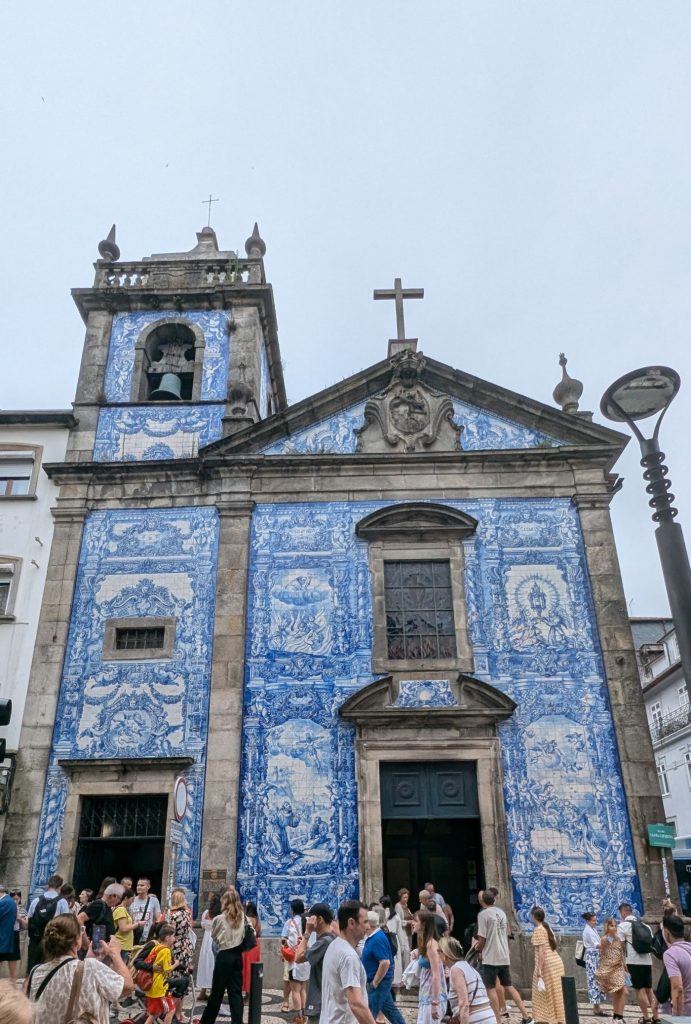
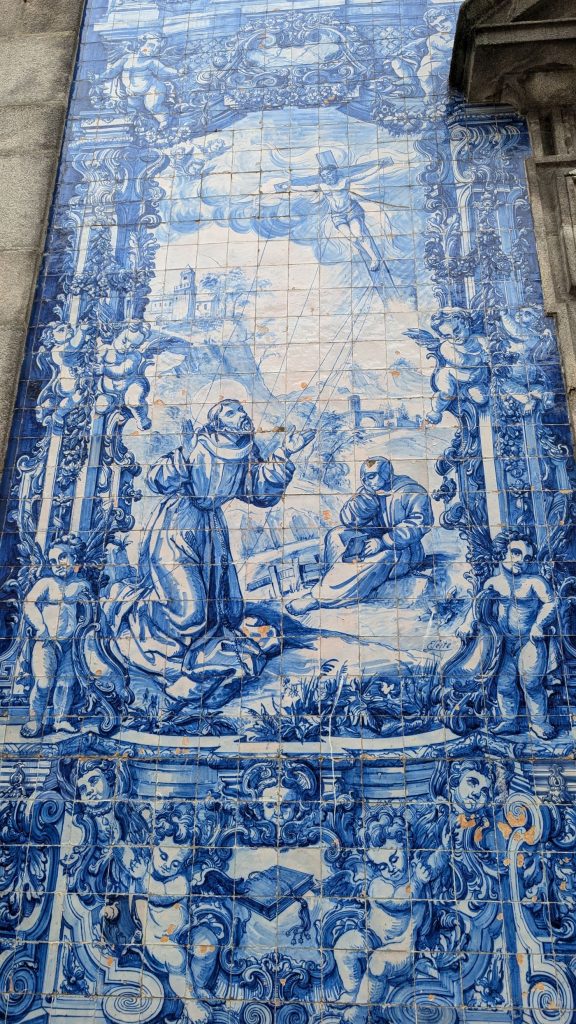
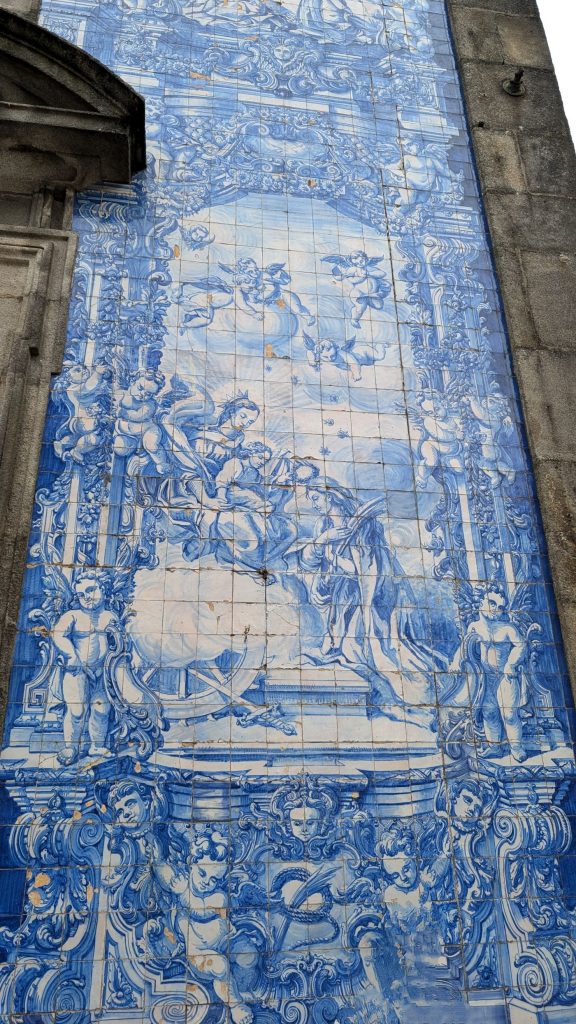
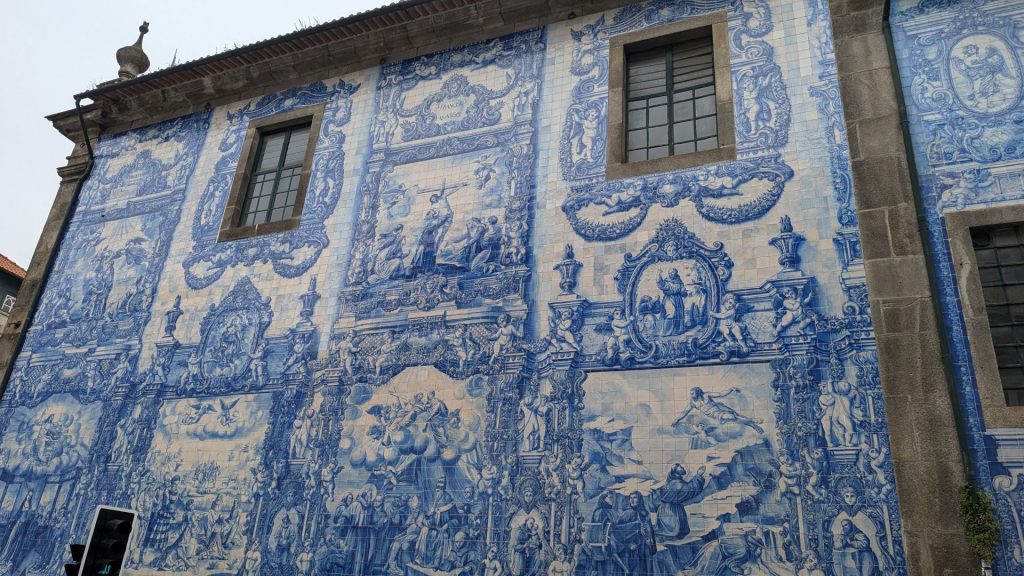
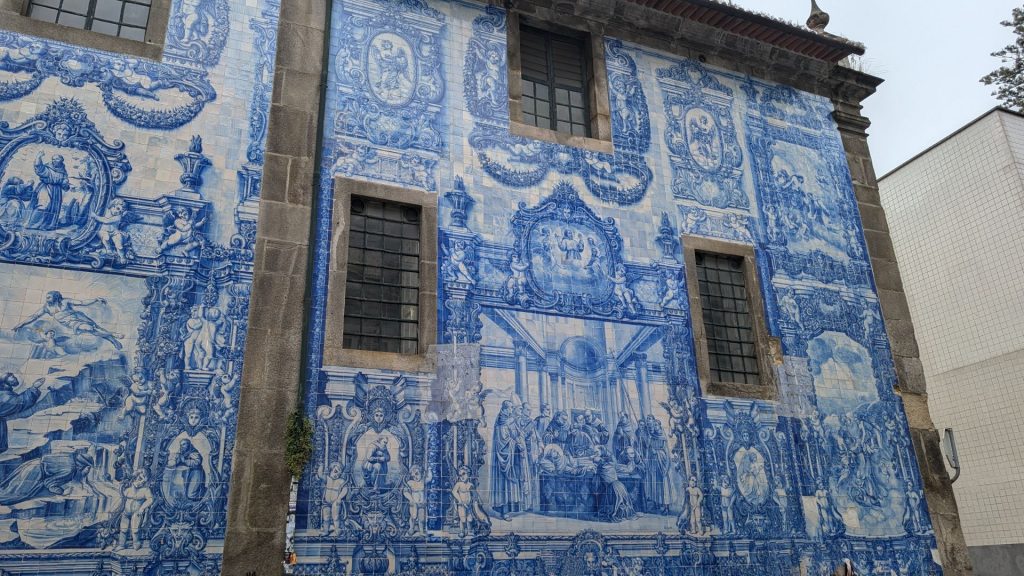
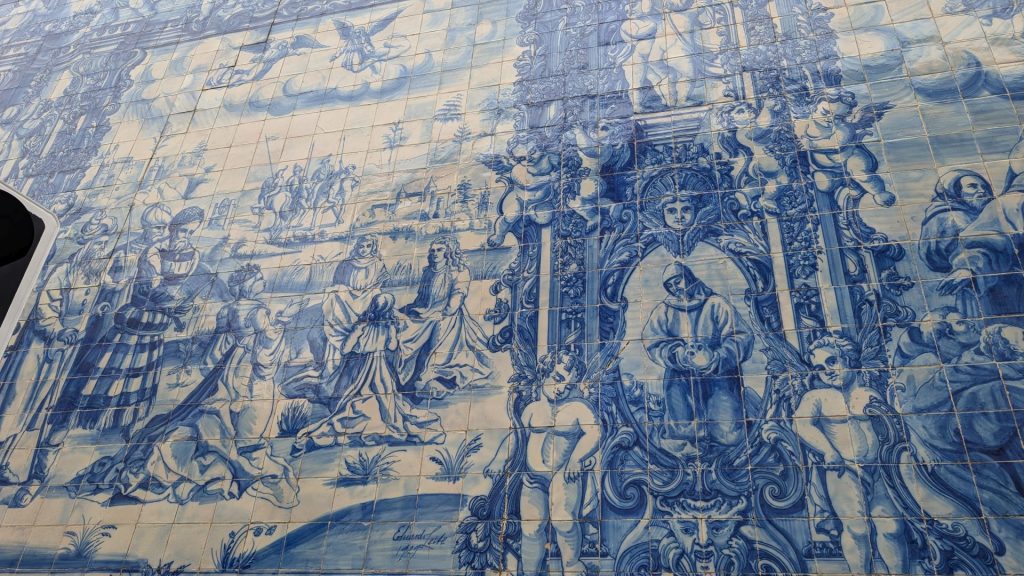
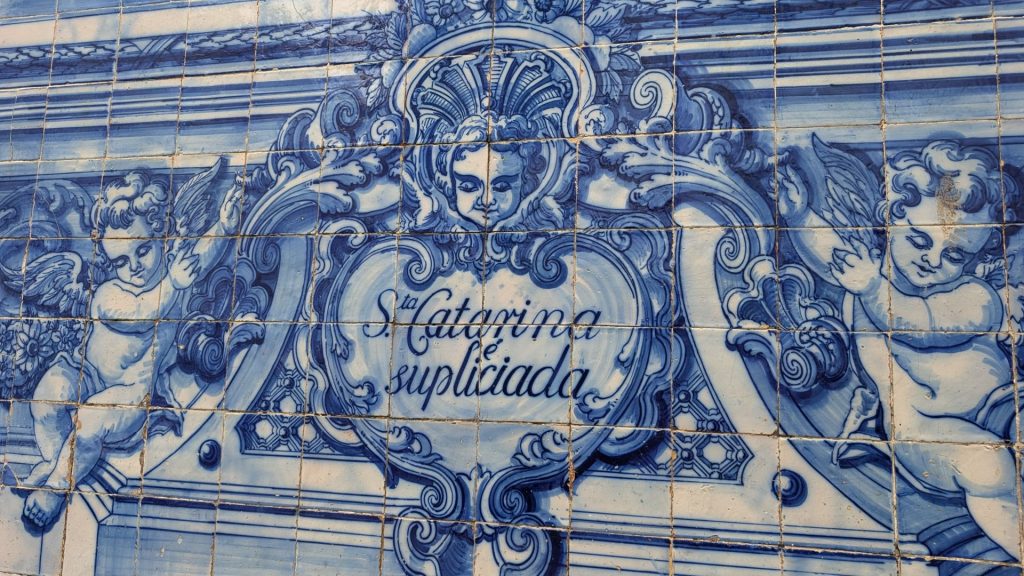
The inside is nice. It isn’t as ornate as some, but I think it fits this chapel perfectly.
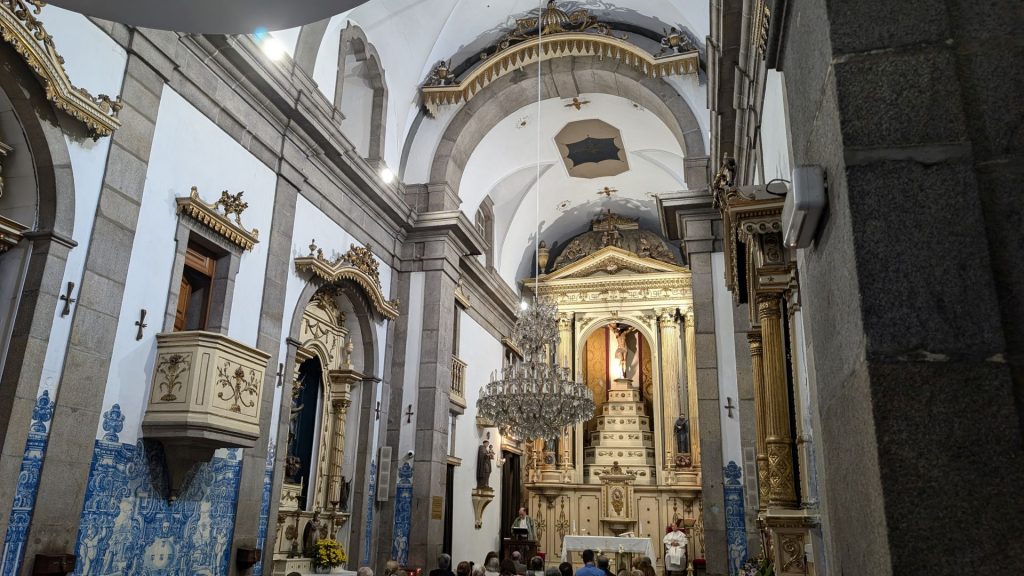
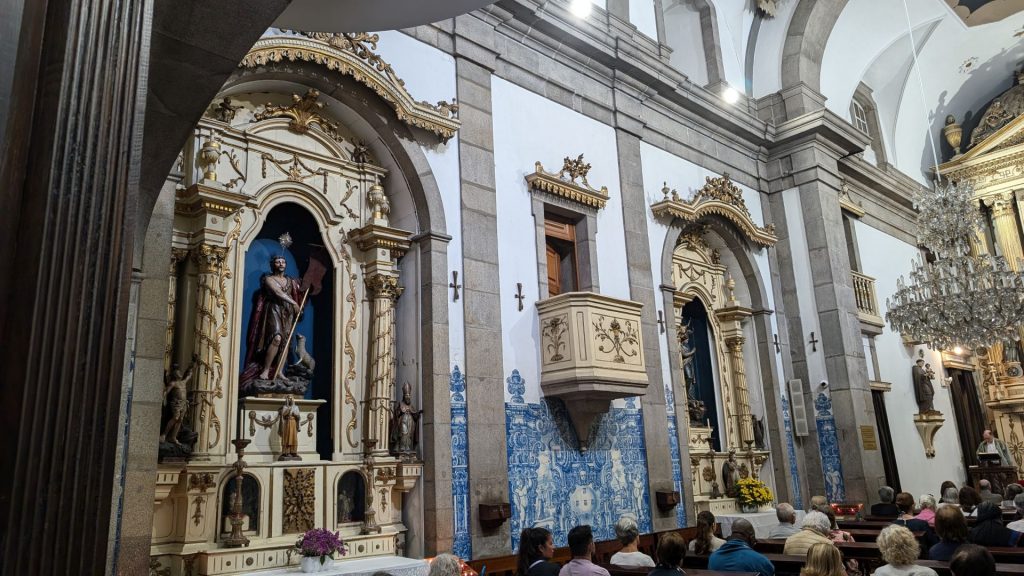
And then there’s this guy advertising an extra 10% off for. . . weeks adjoining??
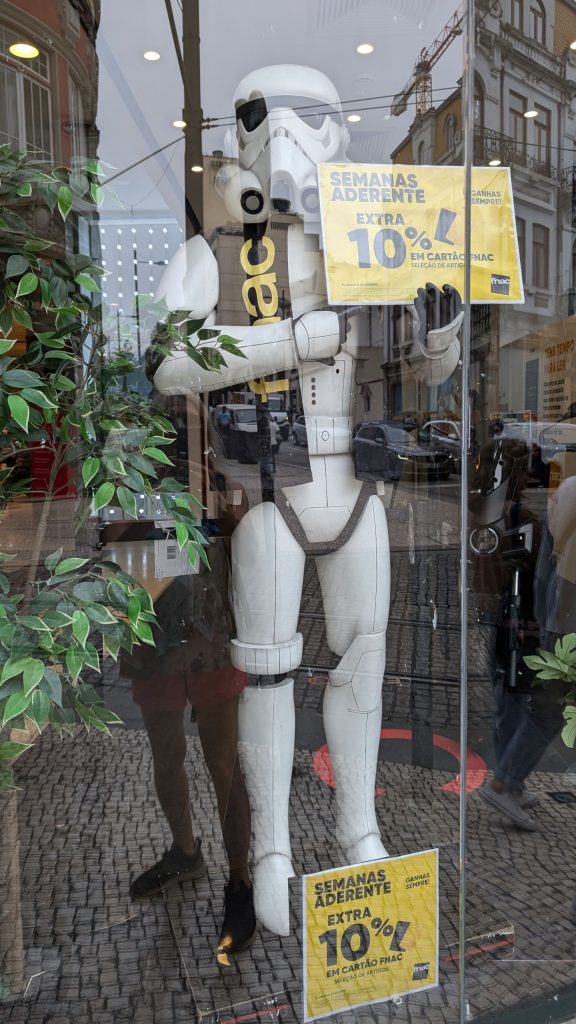
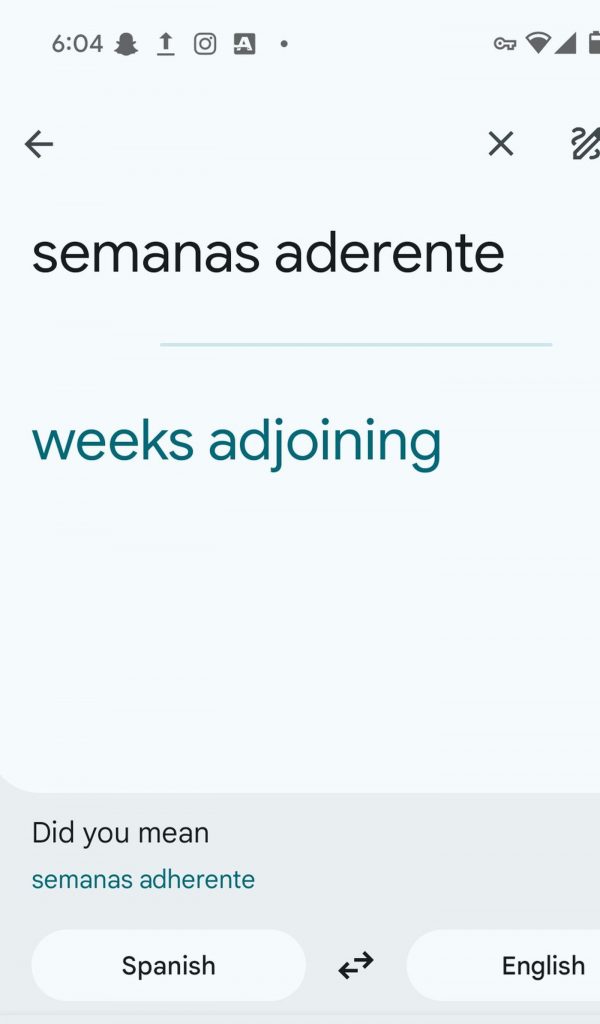
Let’s move on.
Here are some sights along the way to Porto Cathedral. There was a little art fair, so I bought a cork purse. I’d purchased one in Madeira years before but the zipper had broken, so I was happy to replace it.
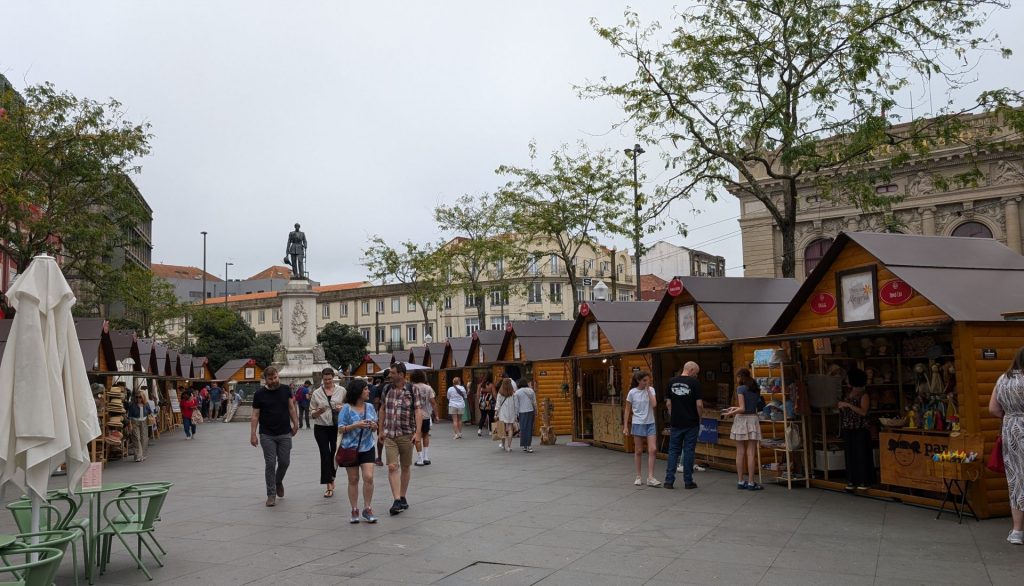
At the time of our visit to Portugal, candidates for the US president and vice president positions were busy campaigning. JD Vance-R, VP candidate, had attempted to insult Kamala Harris-D, presidential candidate, by calling her a “childless cat lady.” When I saw this building, I told my friends that I’d found where the childless cat ladies of Porto resided.
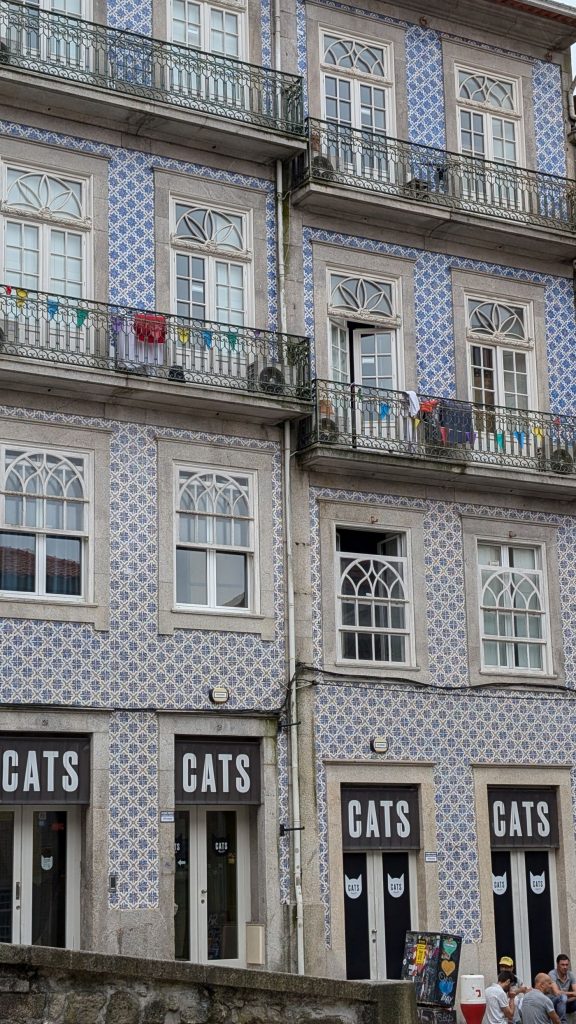
This statue (below) is of Vimara Peres, (820-873), a Galician duke of the 9th century in west Iberia. He was a vassal of the king of Asturias, Léon and Galicia, Alfonso III, and was sent to reconquer and secure from the Moors the area from the Minho River to the Douro River, including the city of Portus Cale, later Porto and Gaia, from where the name of Portugal emerged. In 868, count Vímara Peres was named Count of Portugal, after the reconquest of the region north of the Douro river. Portuguese historians view this event as the earliest milestone in the history of the state of Portugal, although Portugal did not achieve independence until the 12th century. Sculptor: Salvador Barata Feyo (1899 – 1990)
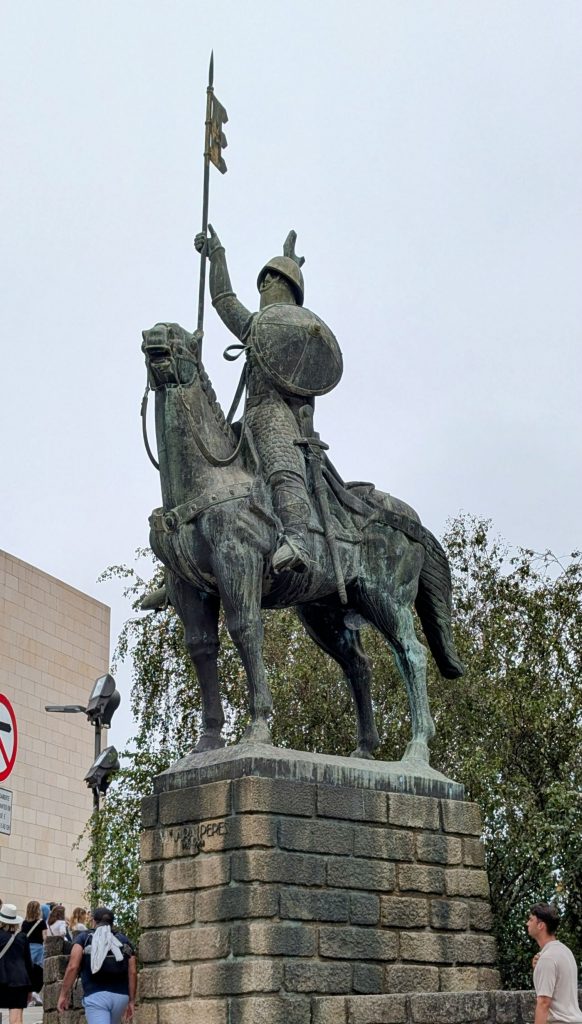
City sights. Porto is quite hilly, so it is easy to find viewpoints.
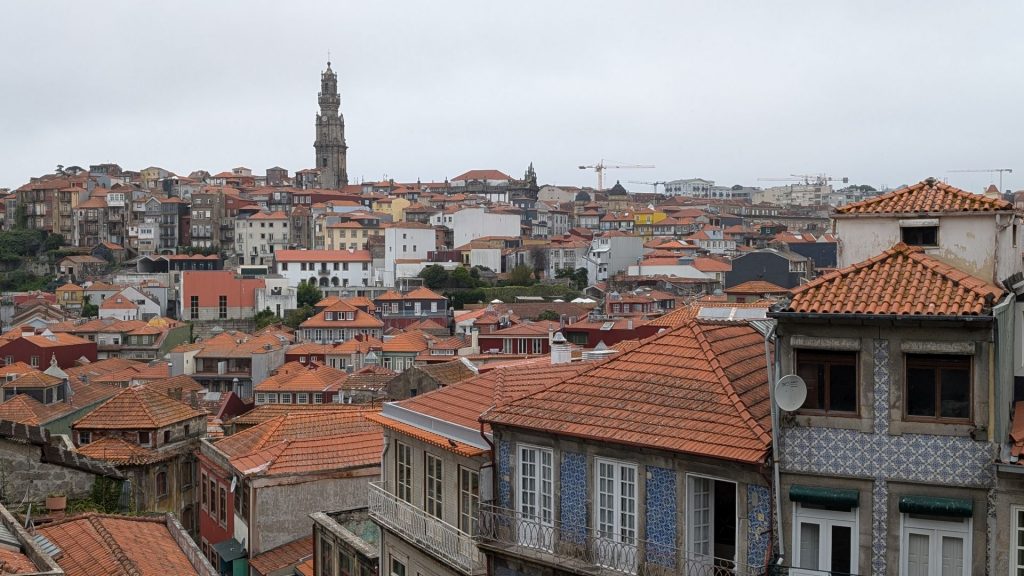
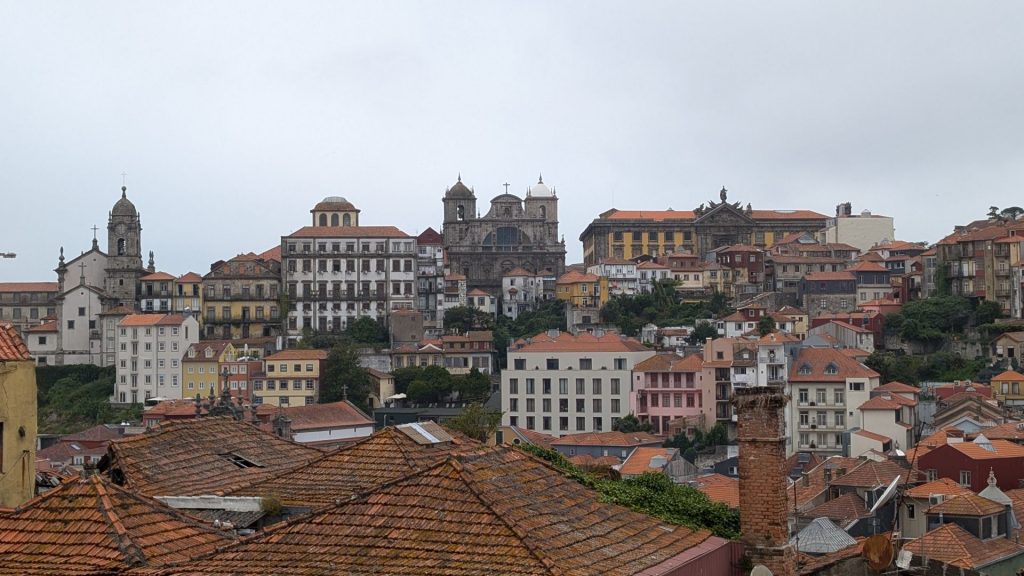
The gent with the spear below is “O Porto.” “O Porto” is a warrior wearing a breastplate that covers his chest and back, with a gladius (a double-edged sword) at his waist, a long spear in his right hand and a shield in his left hand, placed high, showing the coat of arms of Porto and the inscription Portus Cale. His head is covered with a military helmet topped by a dragon. (How cool is that!) The warrior is wrapped in a patterned cape and wears a kilt that reaches above his knees. This is the representation of the city: a warrior, a defender of the city!
The granite statue “O Porto” was designed by the saint-maker João de Sousa Alão and commissioned from the master mason João Silva, who sculpted it in 1818.
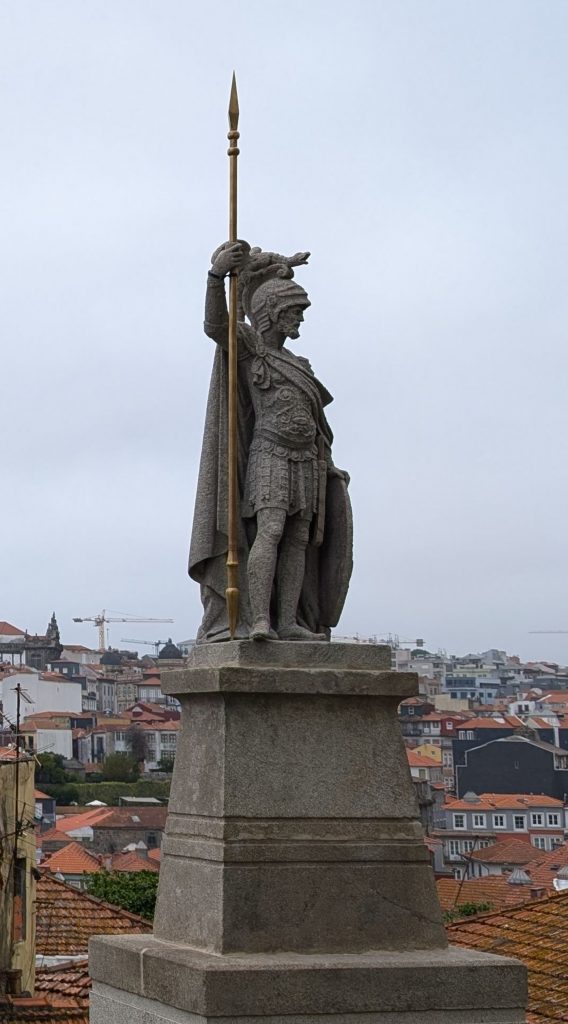
Pillory of Porto
The ornately carved twisting stone pillory is called a pelourinho by the Portuguese. This pillory is a reconstruction of a 1797 engraving and was inaugurated in 1945. It is a symbol of power and justice, but these days it is primarily used as a meeting place.
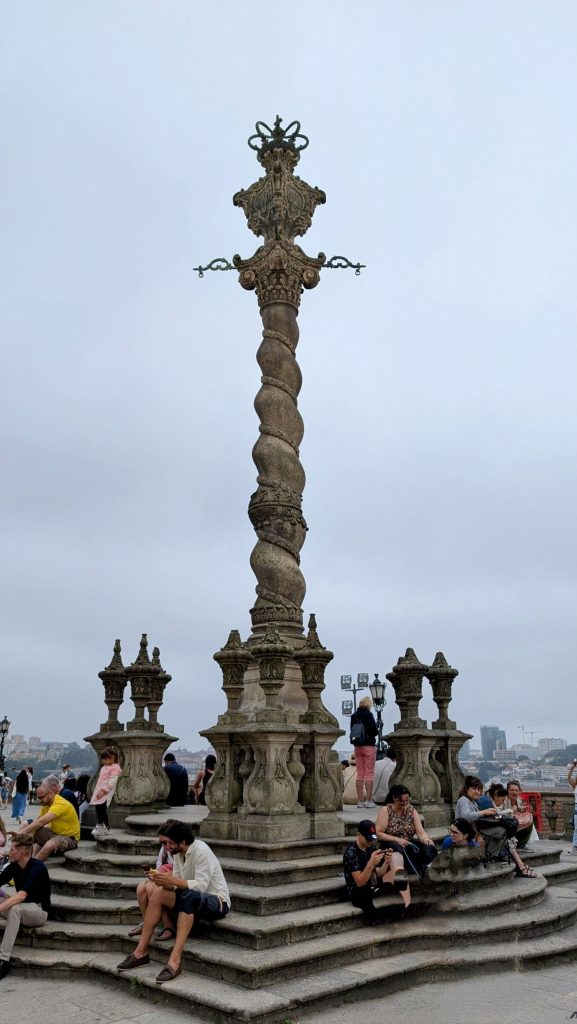
We have now reached Porto Cathedral. Known as Sé do Porto or the Cathedral of Saint Mary of Porto, this iconic structure has captivated the imaginations of both locals and visitors alike. With its breathtaking design and deep historical importance, the Porto Cathedral is a symbol of the city’s cultural heritage.
From https://www.portugal.com/location/porto-cathedral/:
“The history of the Porto Cathedral is closely connected to the city’s fascinating past, with its origins dating back to the 12th century. Construction of the cathedral began in 1110 under the support of Bishop Hugo and lasted for many decades. This Romanesque structure served as a spiritual sanctuary and symbolized the influence of the Catholic Church in the region.
Over the centuries, the Porto Cathedral has gone through renovations and additions, reflecting changes in architectural styles and the cultural and religious atmosphere of the time. In the 14th century, the cathedral’s iconic Gothic cloister was added, providing a peaceful space for contemplation amid the busy city.
In the 19th century, the cathedral served as a refuge for the city’s residents during periods of political unrest and conflicts. Its strong walls and imposing presence offered comfort and protection to those seeking shelter during turbulent times.
The cathedral’s architecture is a captivating blend of different styles that have developed over many years. This magnificent building combines elements of Romanesque, Gothic, and Baroque architecture, creating a beautiful and harmonious design.
The Romanesque influence is most noticeable in the cathedral’s impressive exterior. The strong granite structure is adorned with detailed carvings and ornate decorations, reflecting the solid and sturdy style of the Romanesque period. The main entrance, highlighted by a stunning rose window, immediately captures attention and sets the tone for the cathedral’s grandeur.
Upon entering the cathedral, one can observe the transition to the Gothic style. Tall and slender columns, soaring arches, and delicate rib vaults create a magical atmosphere reminiscent of the magnificent Gothic architecture found throughout Europe. The interior is further enhanced by exquisite stained glass windows, which fill the space with vibrant colors and a mystical glow, adding to the cathedral’s enchanting appeal.
During the Baroque period, significant changes were made to the Porto Cathedral, enriching its architectural composition even further. Elaborate altarpieces adorned with gold plating, intricate woodwork, and detailed ornamentation transformed the interior, embodying the opulence and grandeur associated with the Baroque style.”
The entrance:
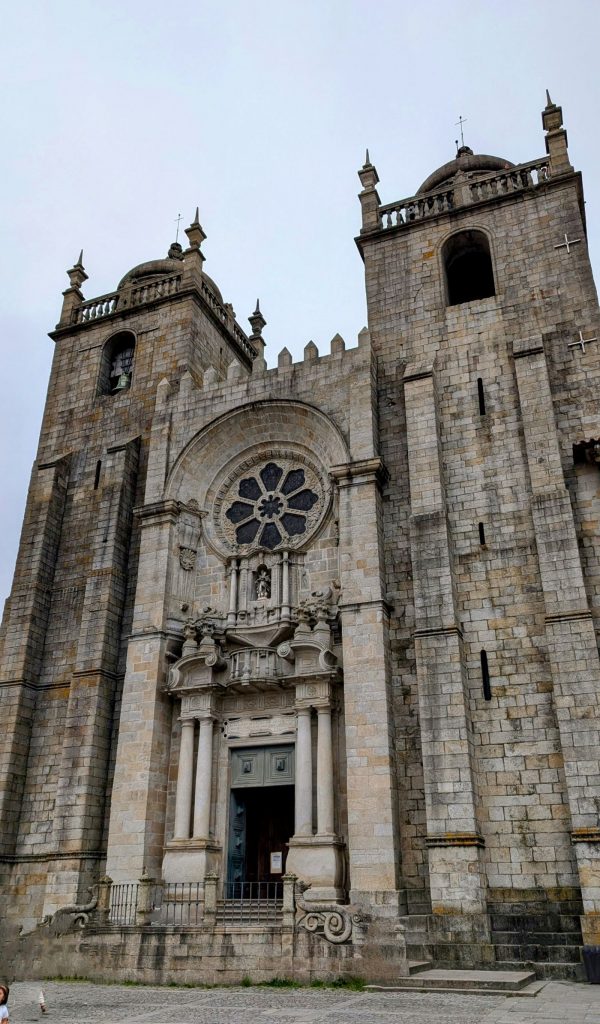
The entry ticket gives access to the church, the cloister, the treasury, and the tower.
Let’s start with the church. The main altar was particularly. . . gold. It is an example of Baroque art, created between 1727 and 1729. It was designed by distinguished Lisbon architects Claude Laprade and Santos Pacheco.
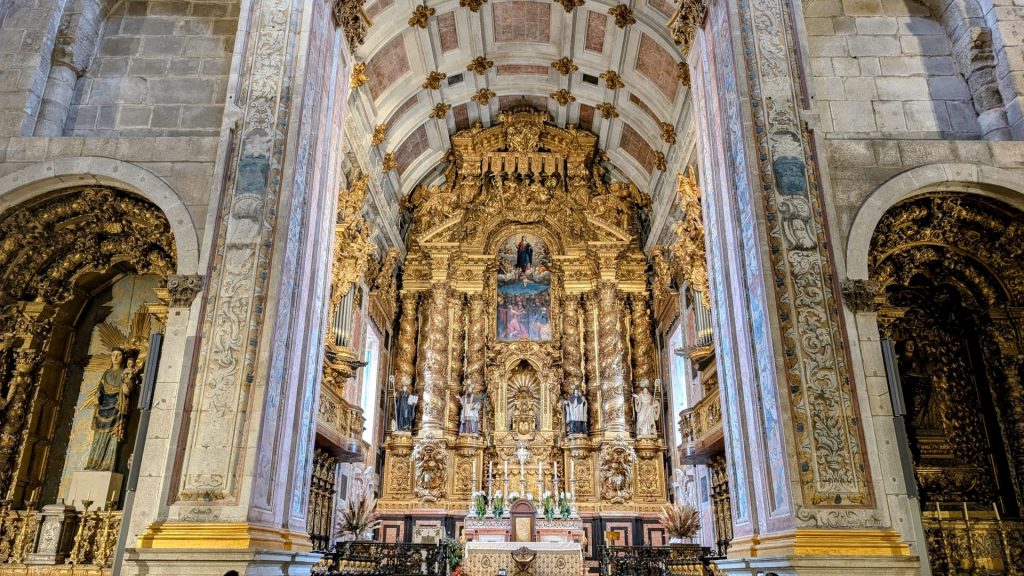
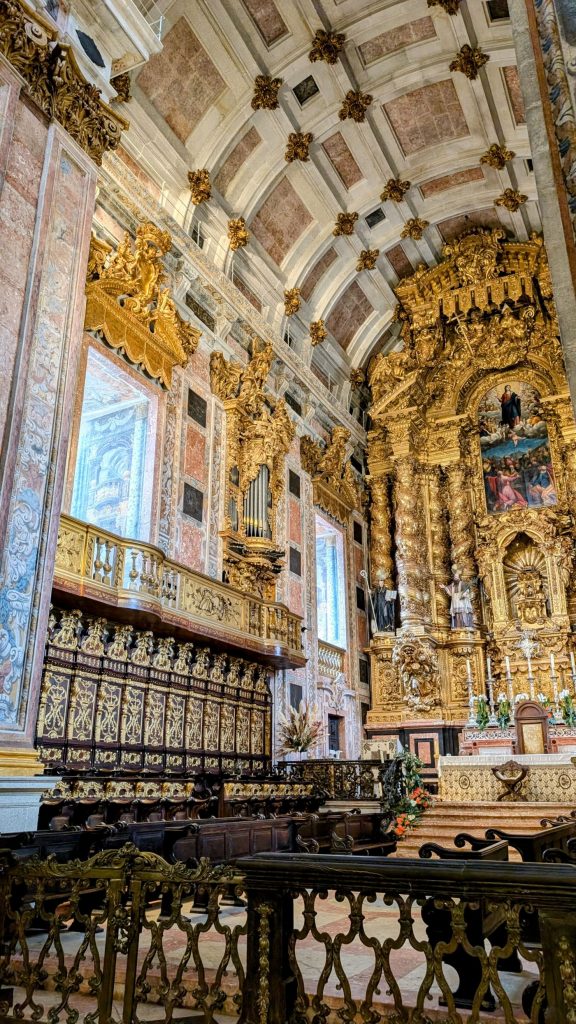
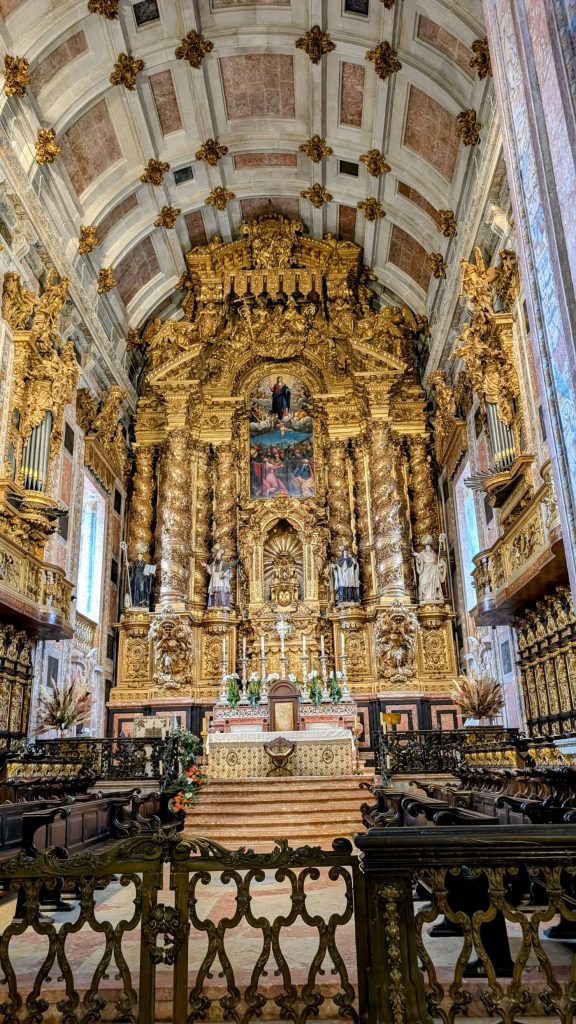
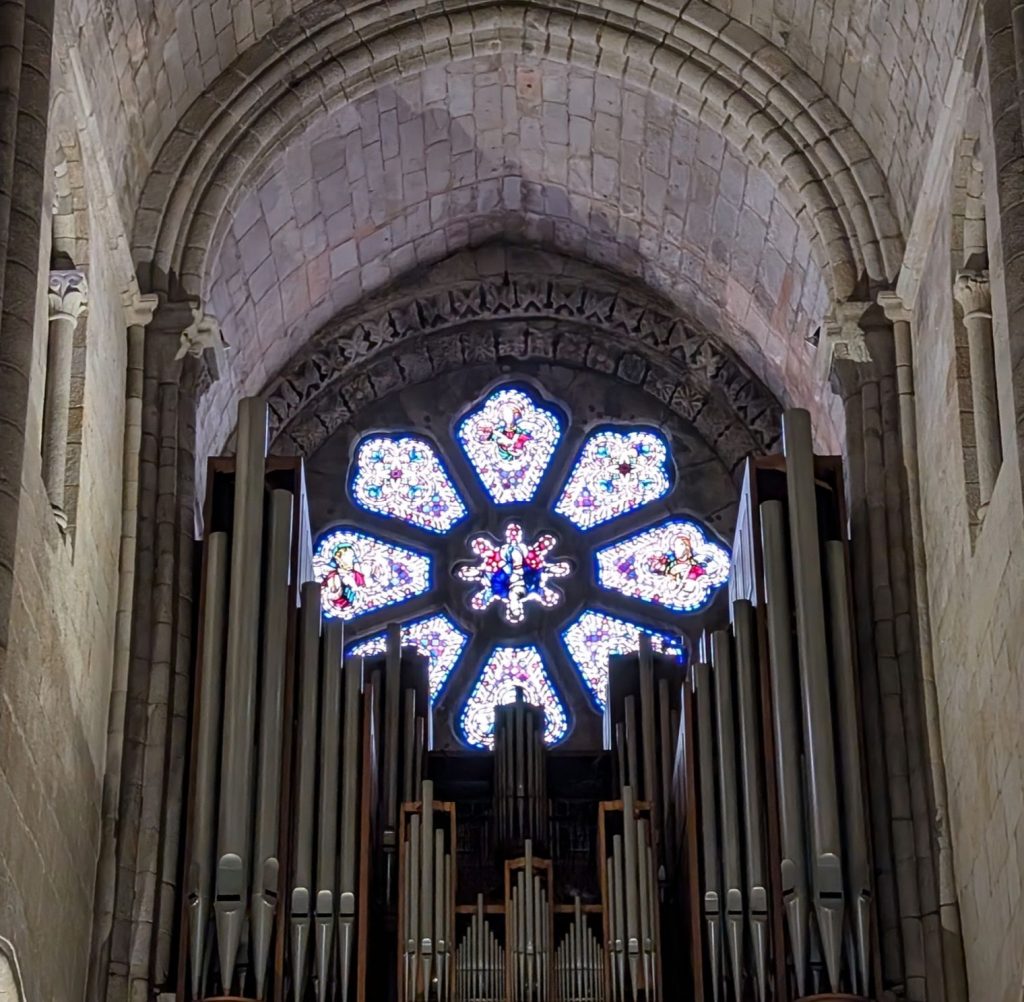
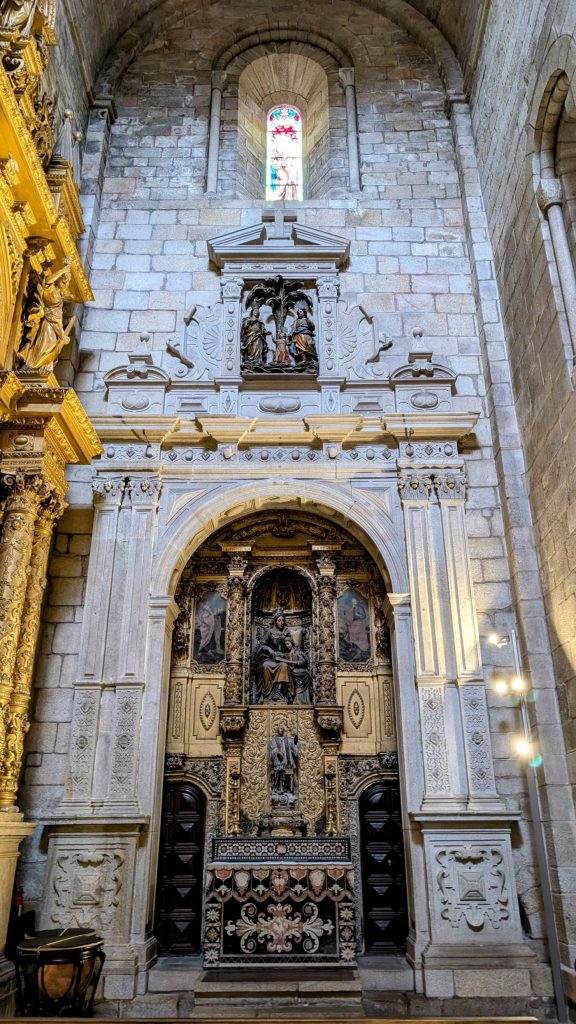
Cathedral Treasury
The treasury is in the chapter house. Some chapter houses were very simply decorated in orders where poverty and devotion to God were extremely important. Other chapter houses like the one at Porto were very richly decorated with scenes from the Bible to give instruction to the monks that occupied the building.
The ground floor of the chapter house served as a granary, while the first floor now houses the cathedral treasury.
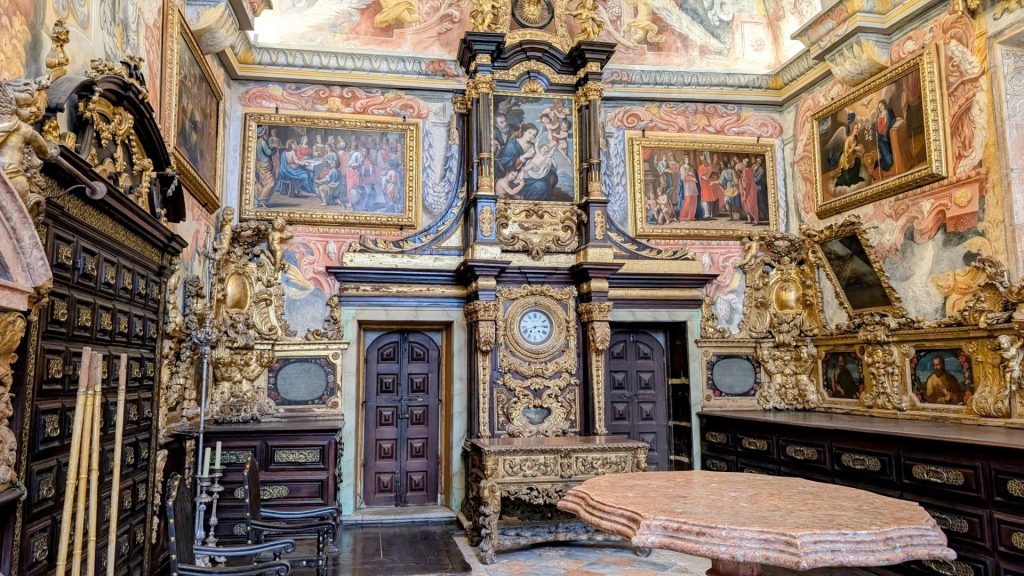
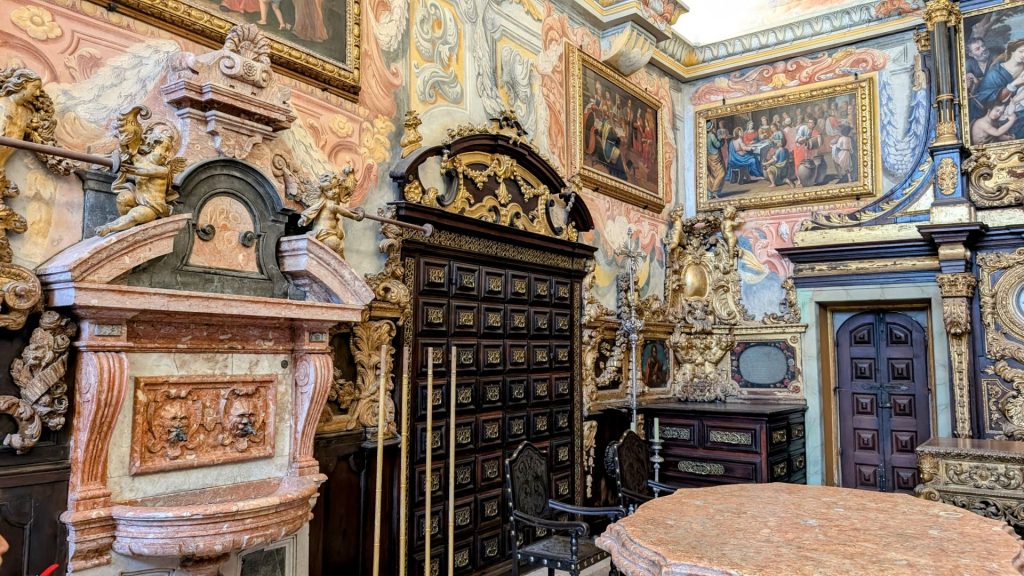
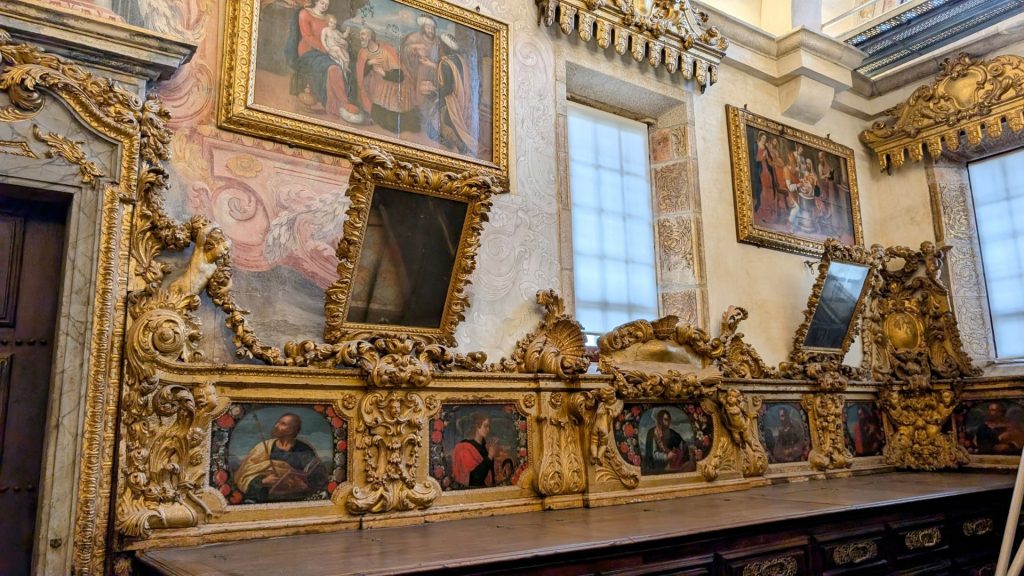
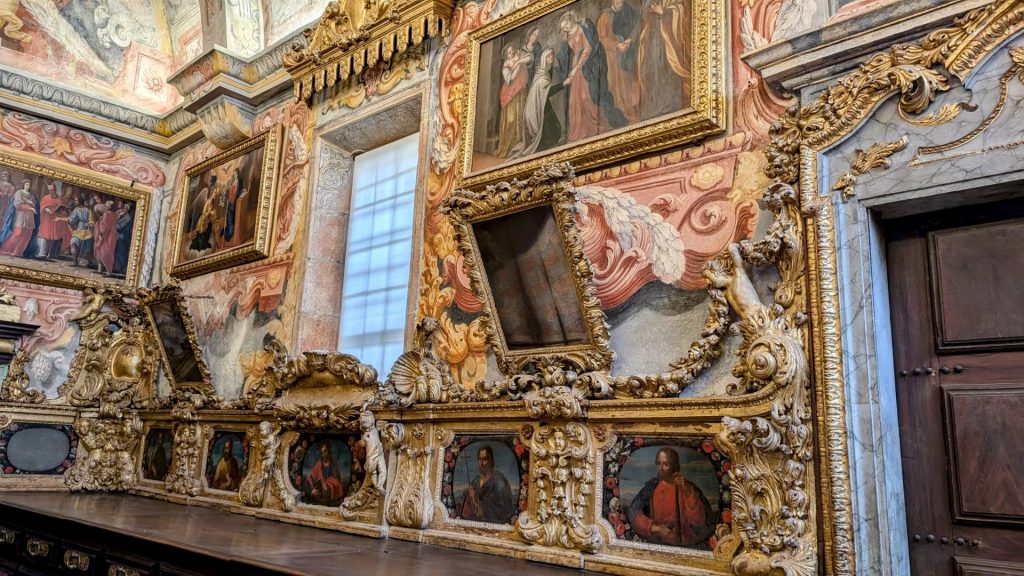
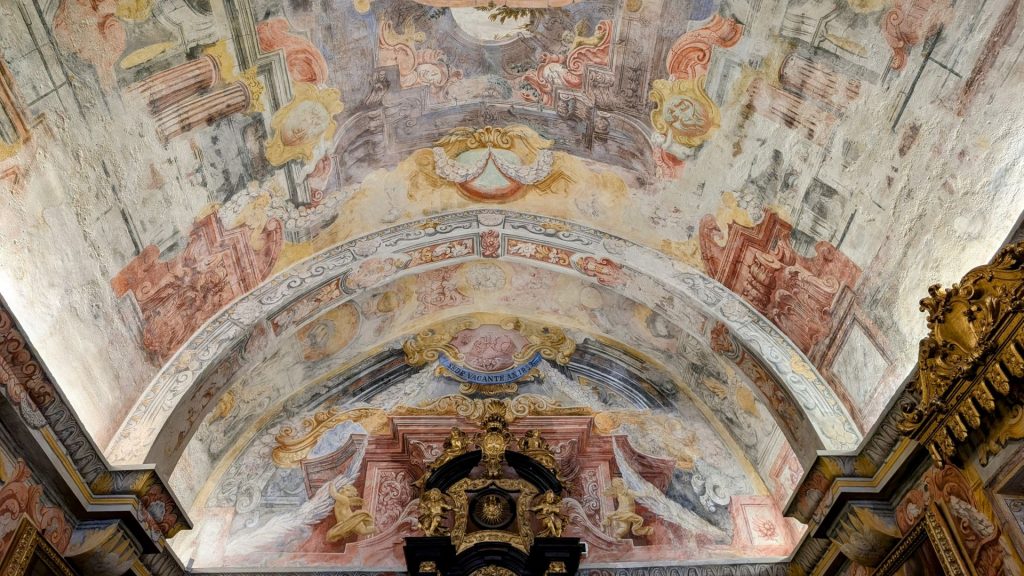
Porto Cathedral’s Gothic Cloisters
The cloisters were commissioned by Bishop John III. They feature 16 double arches carved from stone. A medieval stone crucifix is placed at the cloisters’ center. There are three chapels dedicated to Our Lady in the corners. In the 17th century, the chapels were adorned with azulejos panels by artist Valentim de Almeida, depicting the life of the Virgin and Ovid’s Metamorphoses. There is a second level as well – the terrace. The terrace is decorated with tile panels by António Vidal. These panels consist of images of affluent countryside and mythological scenes.
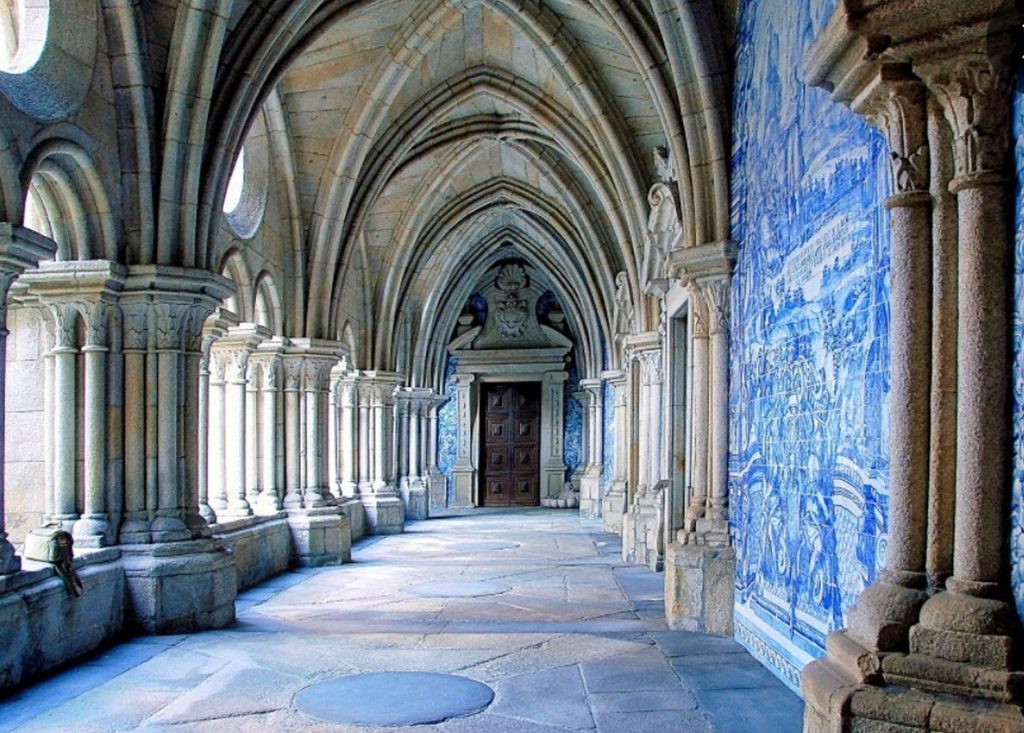
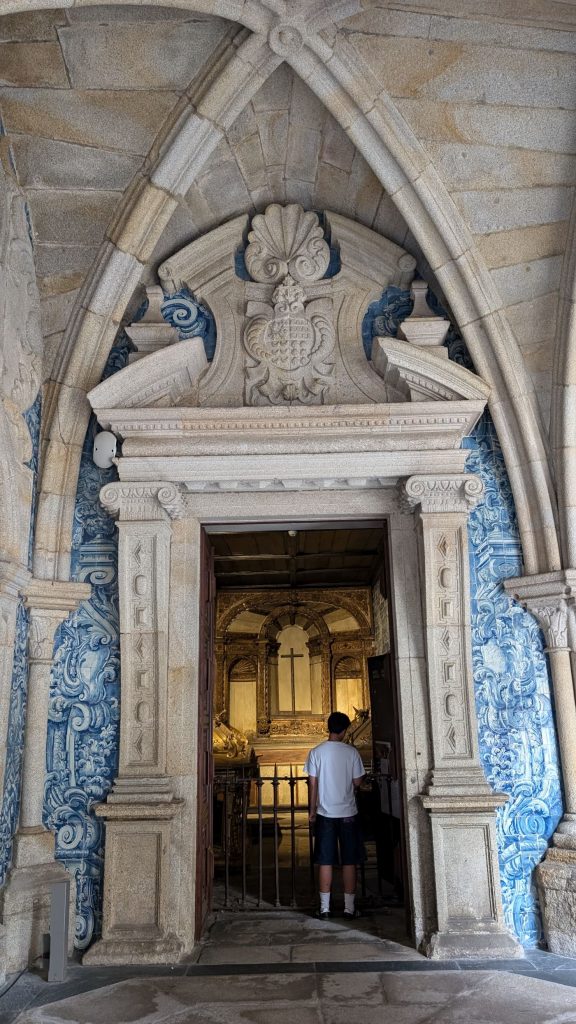
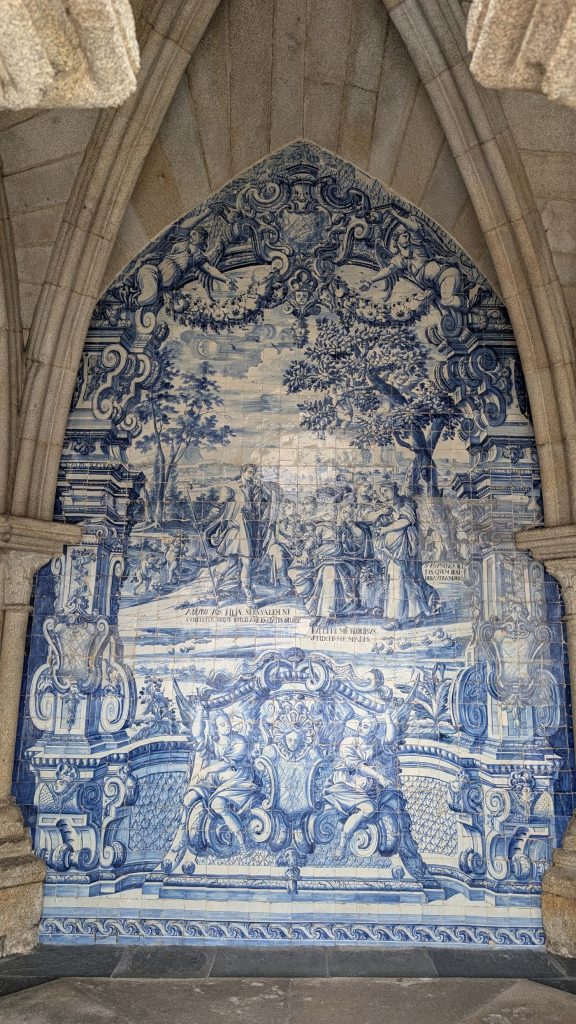
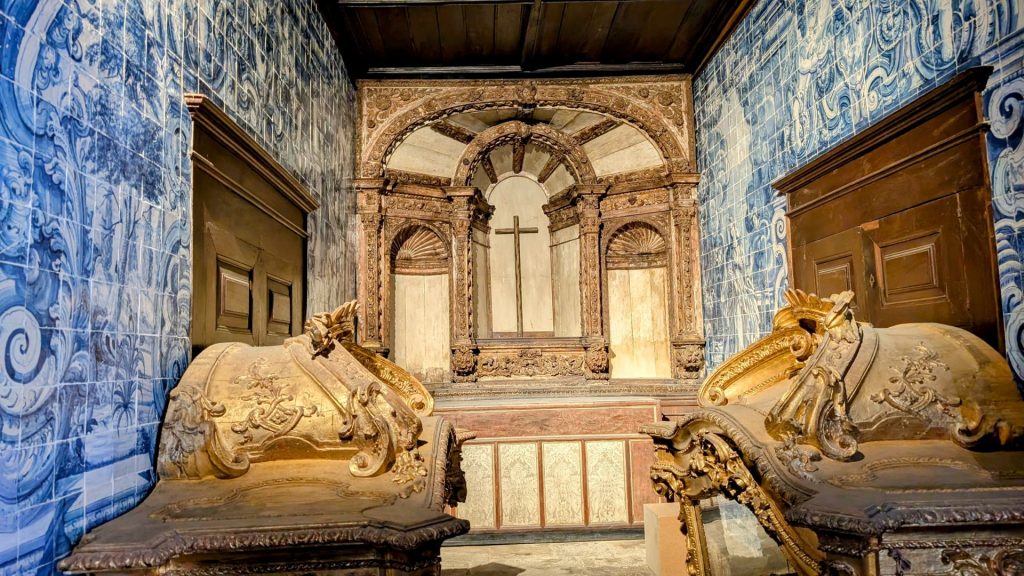
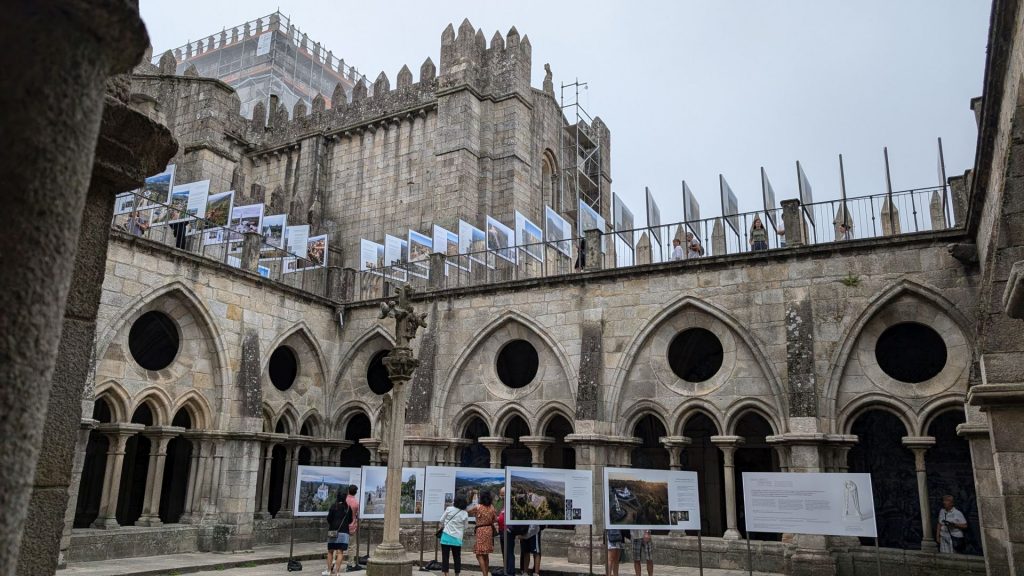
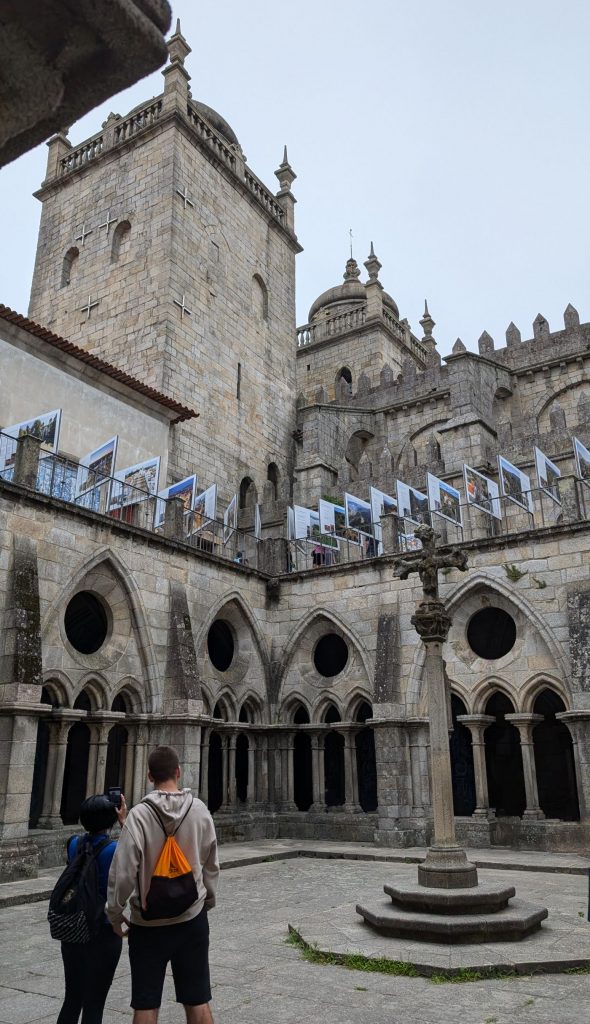
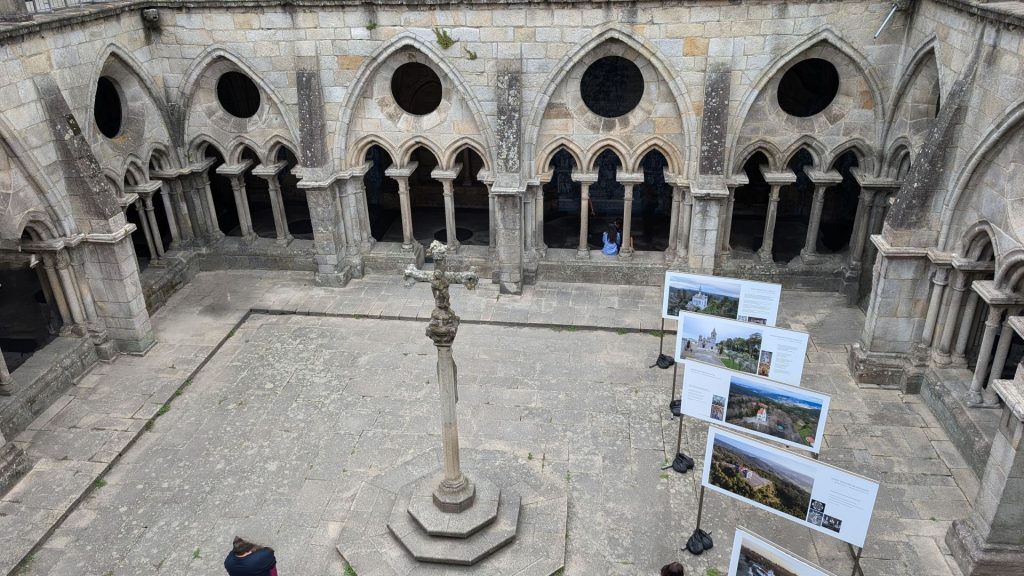
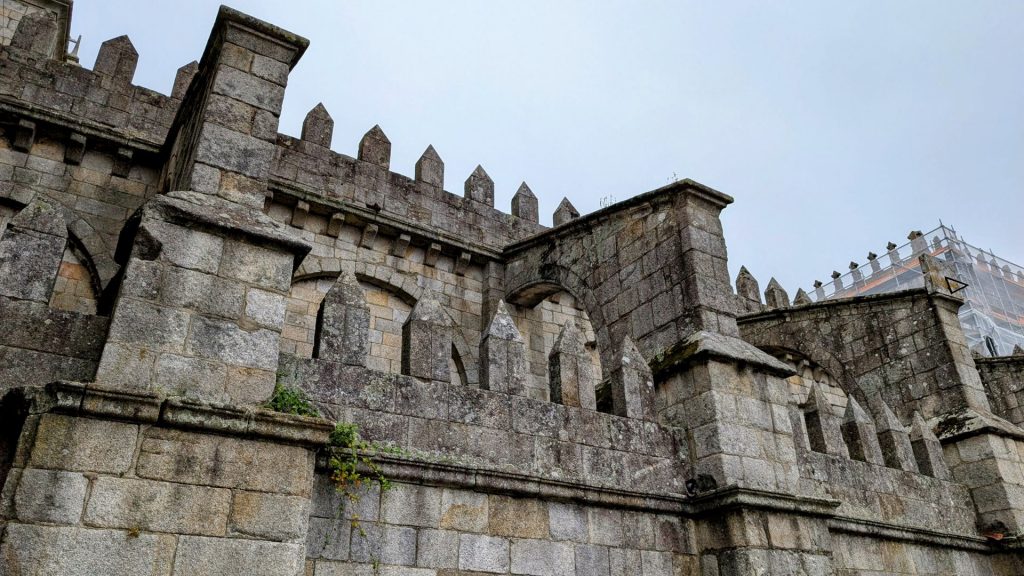
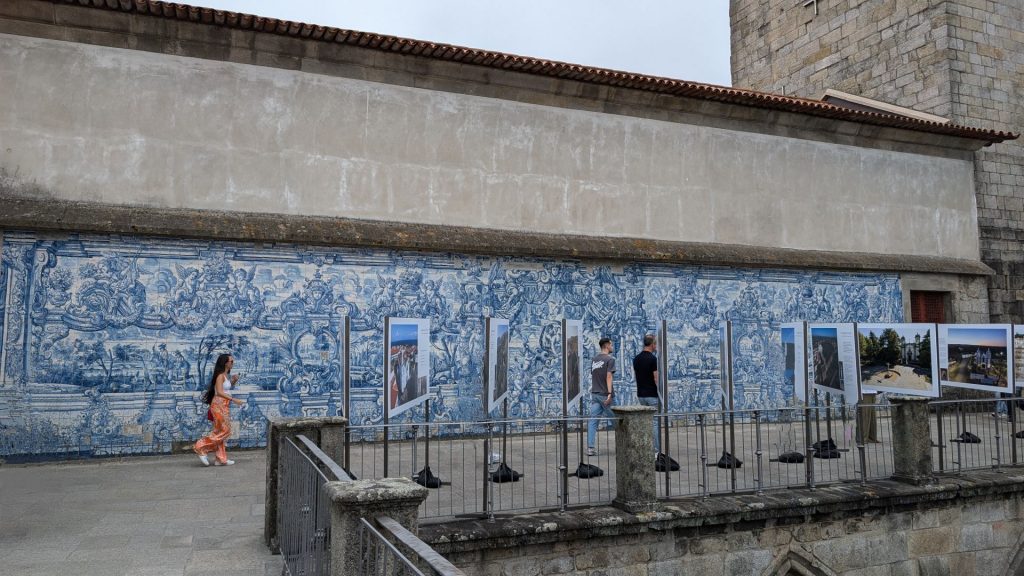
When you see the panels close up, you see just how interesting the images are!
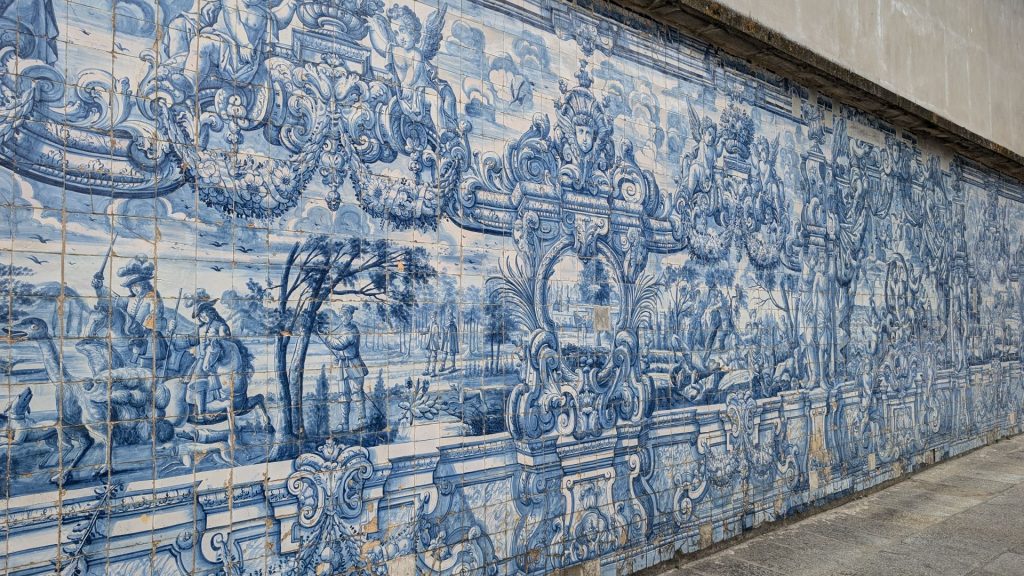
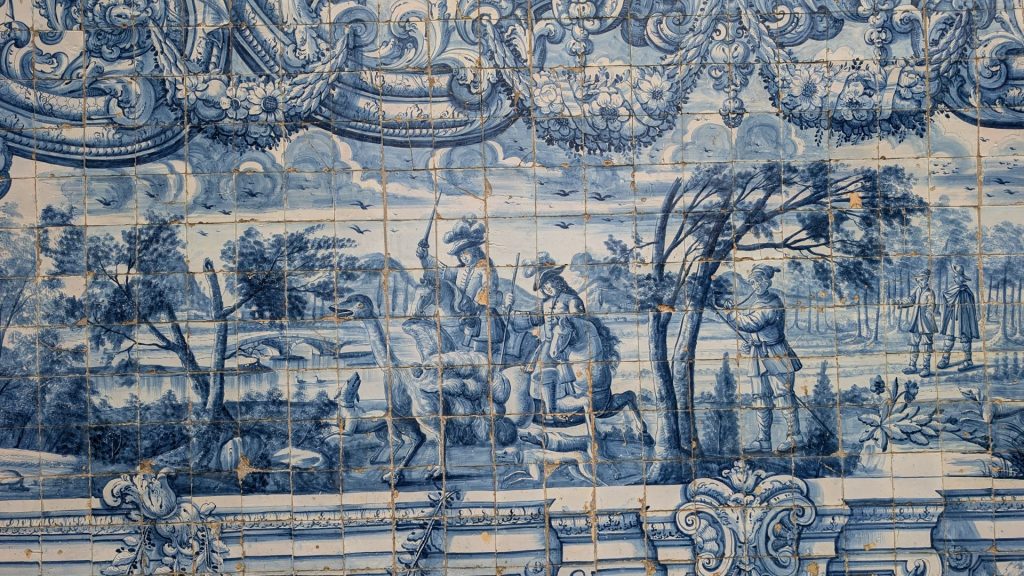
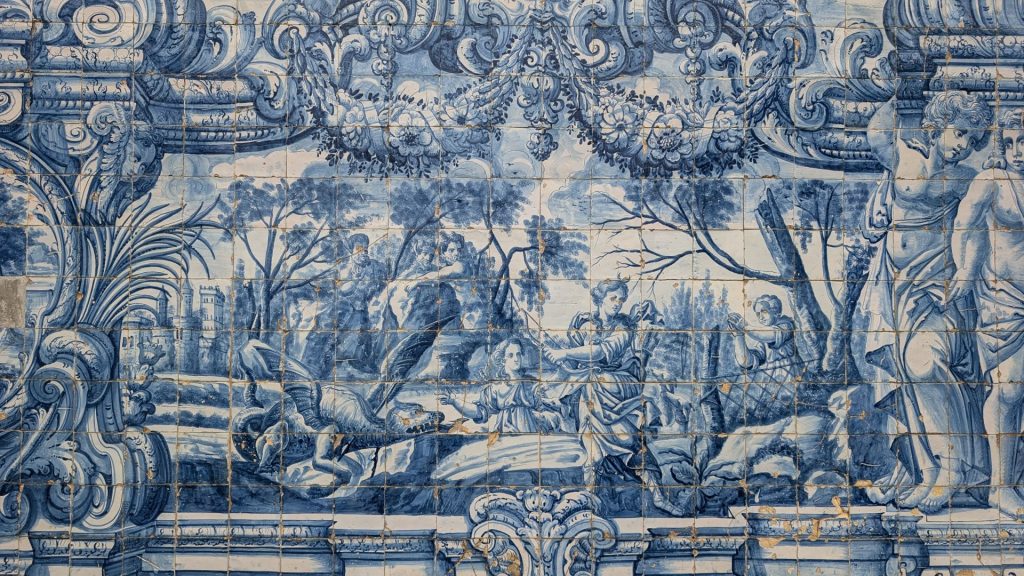
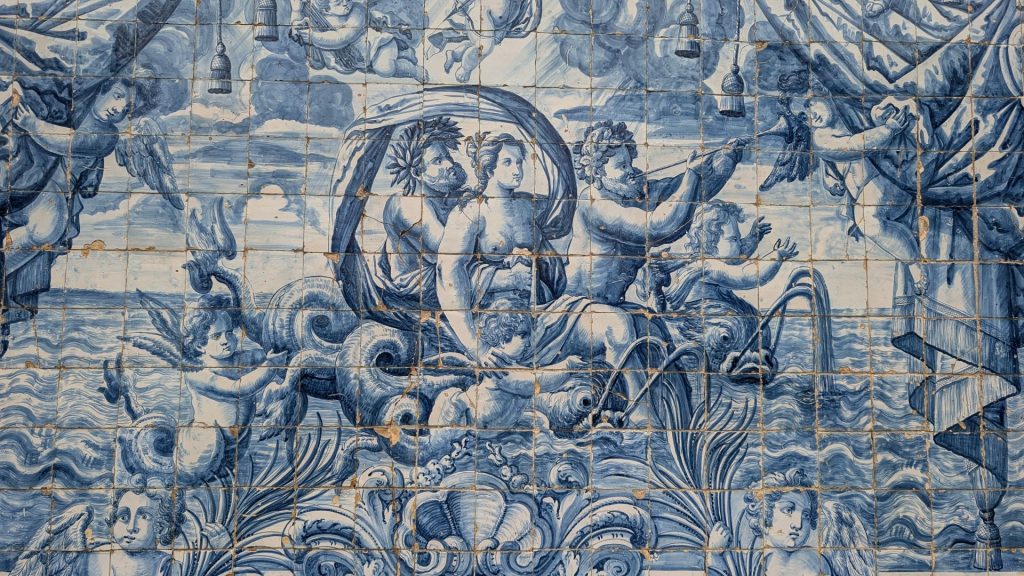
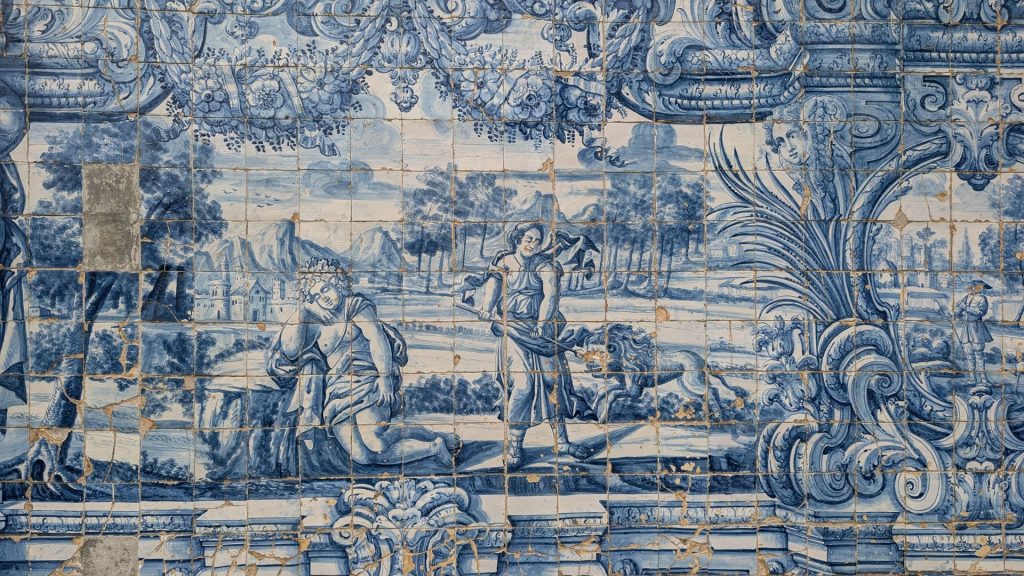
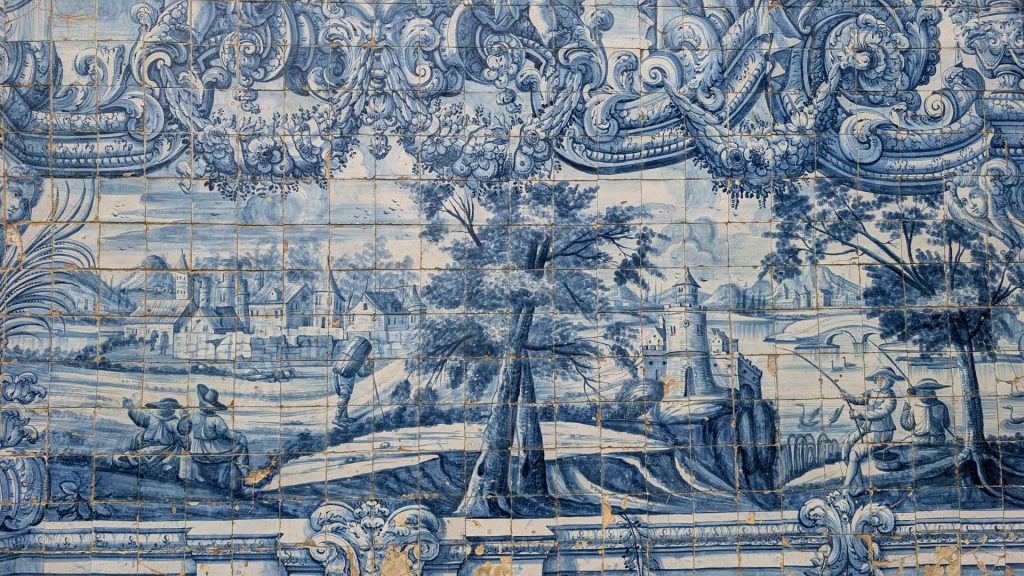
Views from the cathedral:
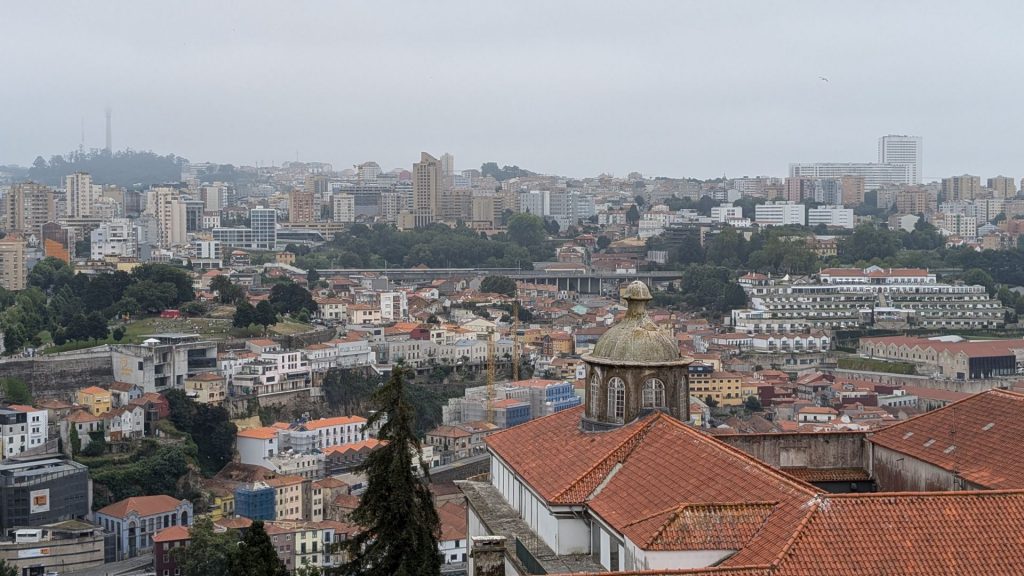
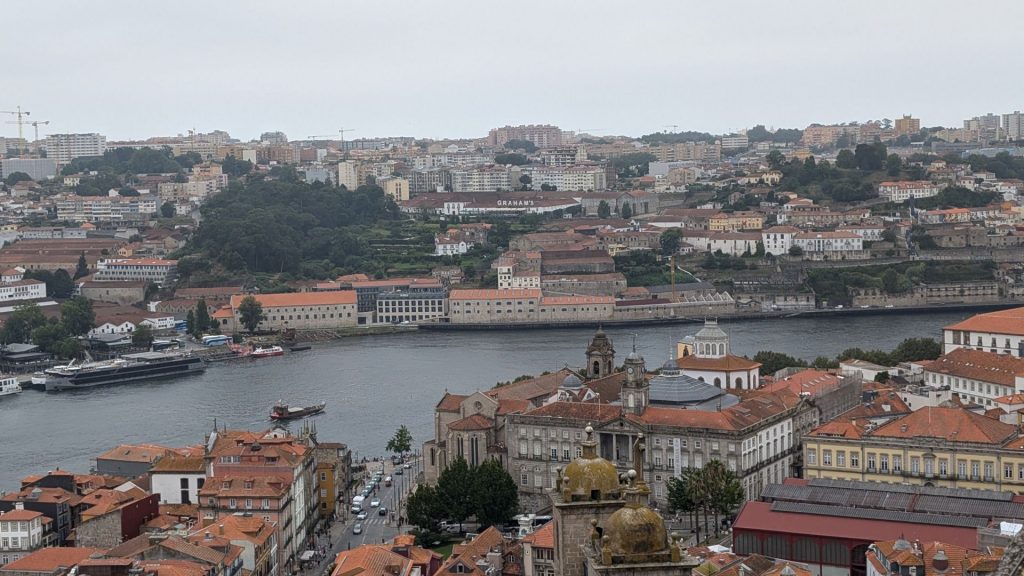
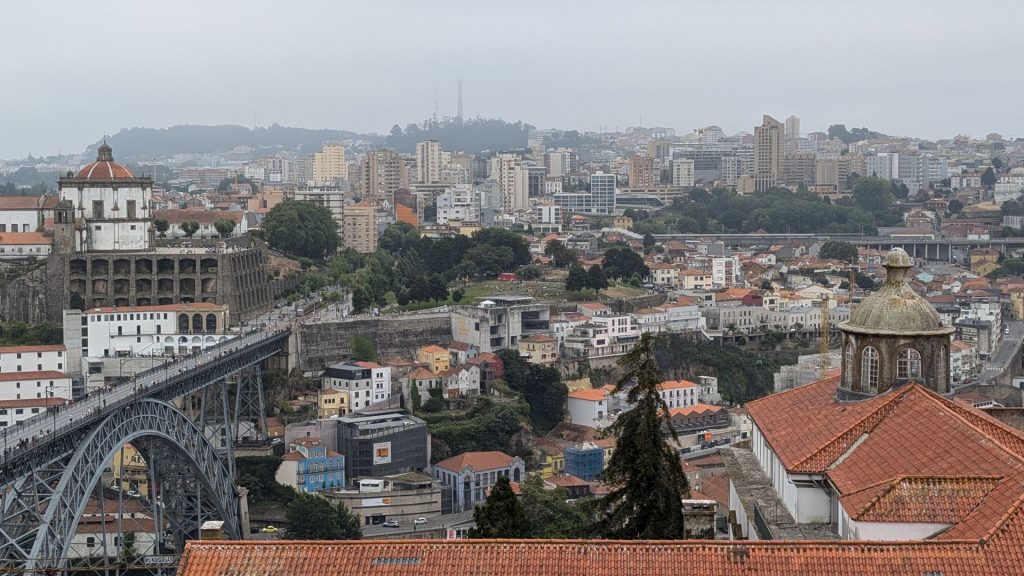
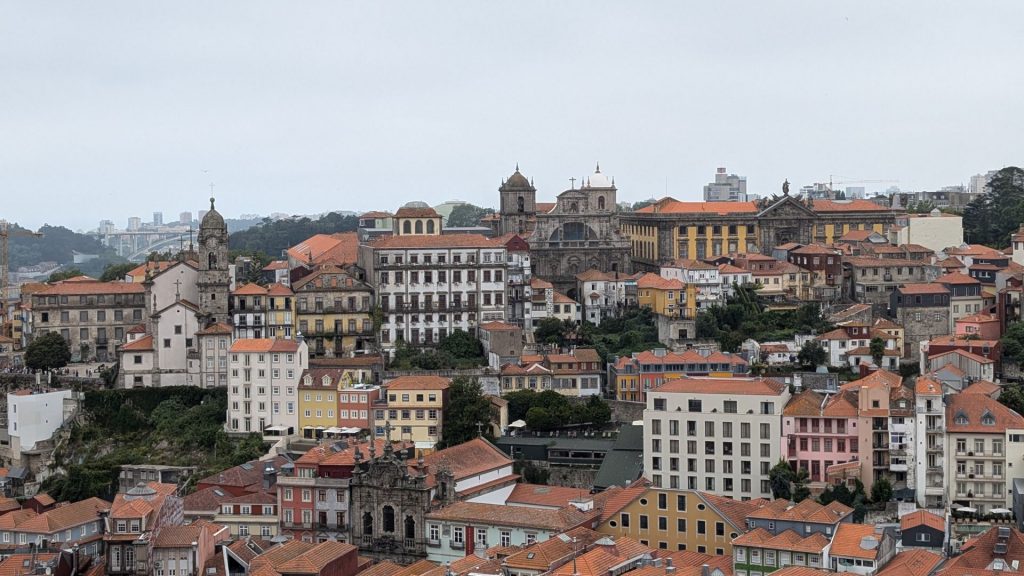
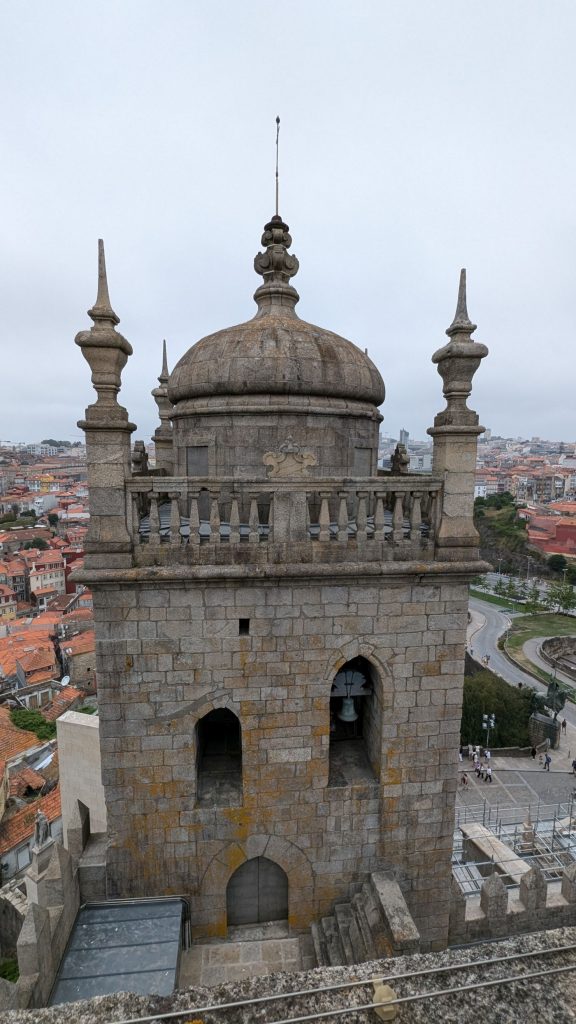
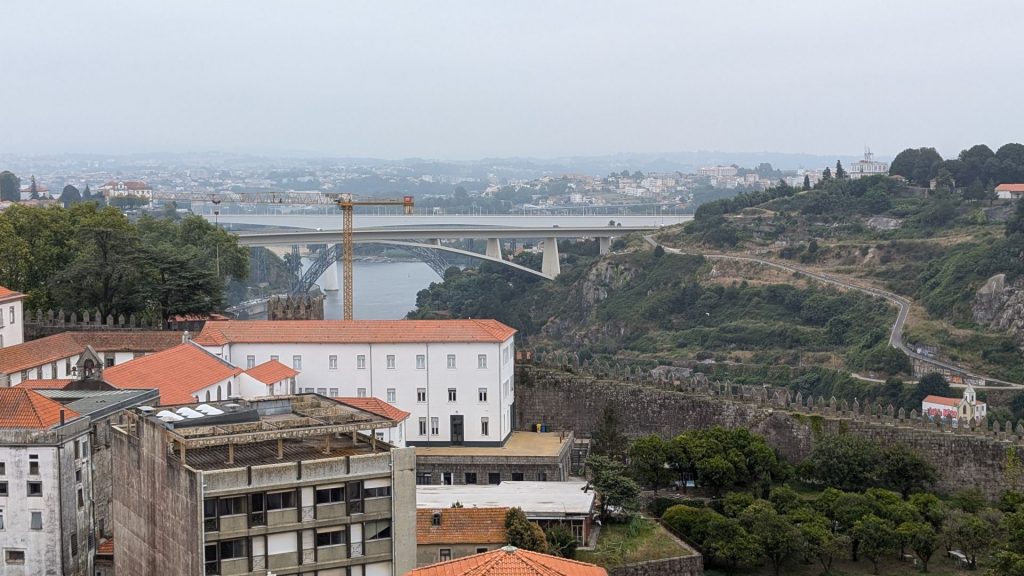
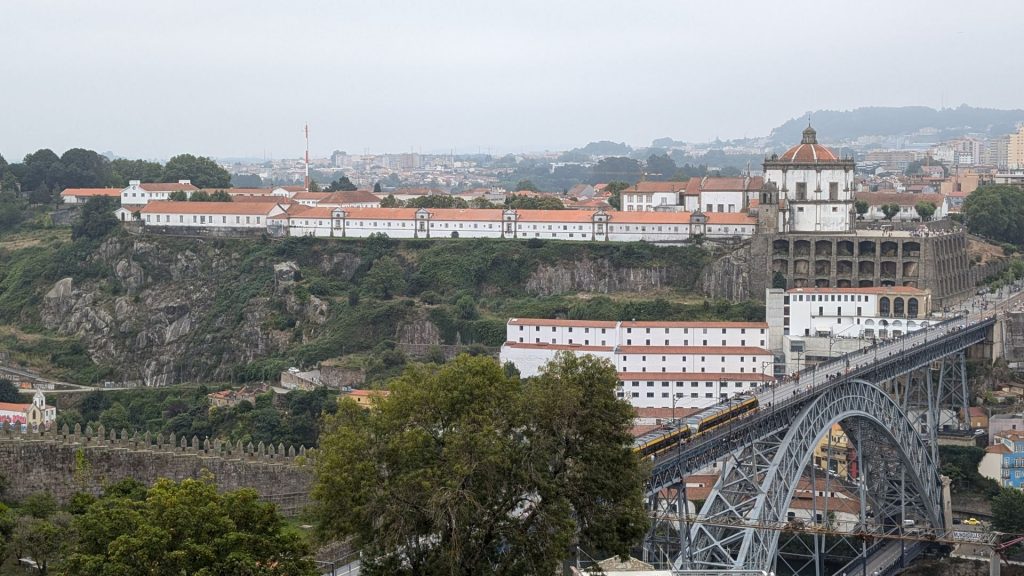
The São Bento Railway station is probably the most beautiful one in Portugal. First opened in 1916, the tile work began five years after the station was built. Portuguese painter Jorge Colaço took inspiration from Portuguese history when he painted the tiles on the station. The main hall features 20,000 tiles telling the history of Portugal, including the Battle of Valdevez and the Conquest of Ceuta, and many other important events in history. It took Jorge Colaço over 10 years (between 1905 and 1916) to complete the mural.
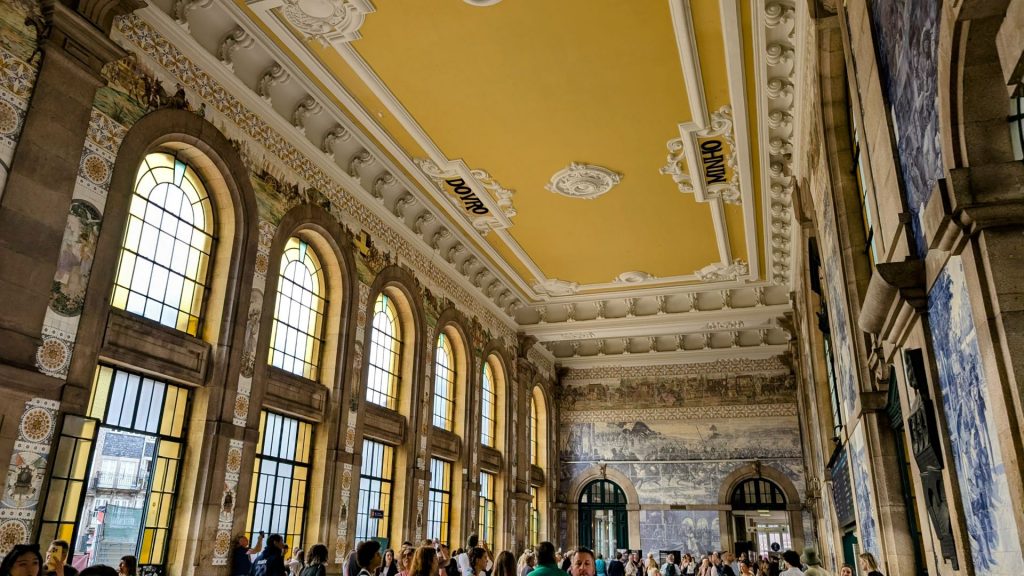
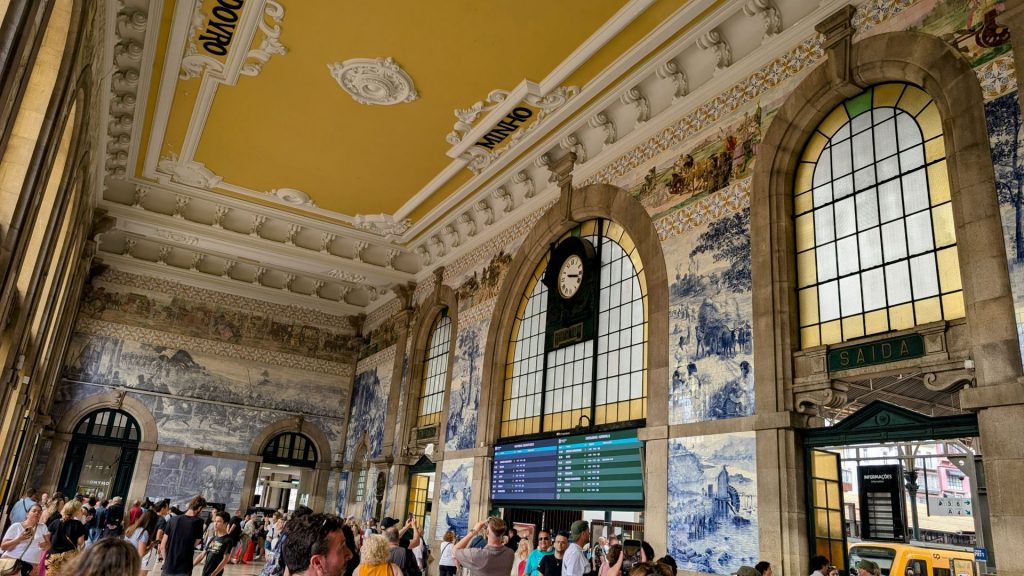
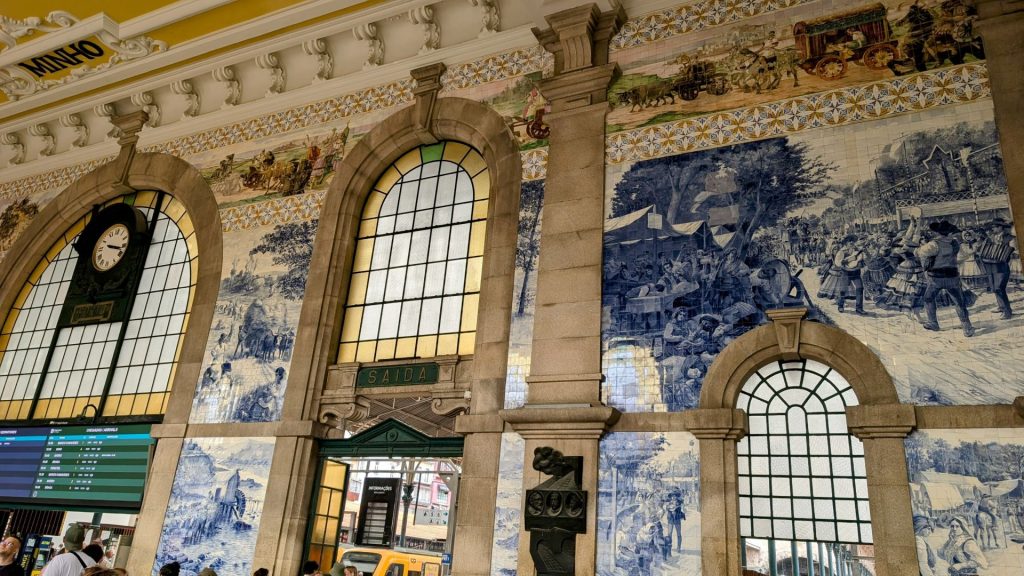
We took a guided tour when we visited the Palácio da Bolsa. (I think that is the only way to see it.) While waiting for it to begin, we checked out the statue in front of the Palácio: the statue of Henry the Navigator.
Henry the Navigator (1394-1460) was a Portuguese prince noted for his patronage of voyages of discovery among the Madeira Islands and along the western coast of Africa. The epithet Navigator, applied to him by the English (though seldom by Portuguese writers), is a misnomer, as he himself never embarked on any exploratory voyages.
Not everything I read about him is glowing. Some authors are down right critical of parts of his legacy (as they should be). If you want to read Henry’s, here are several resources:
https://www.britannica.com/biography/Henry-the-Navigator
https://education.nationalgeographic.org/resource/legacy-henry-navigator/
https://www.biography.com/history-culture/henry-the-navigator
https://www.usni.org/magazines/proceedings/1960/november/prince-henry-navigator
https://www.worldhistory.org/Prince_Henry_the_Navigator/
Henry was complex, to be sure, but his statue is pretty cool.
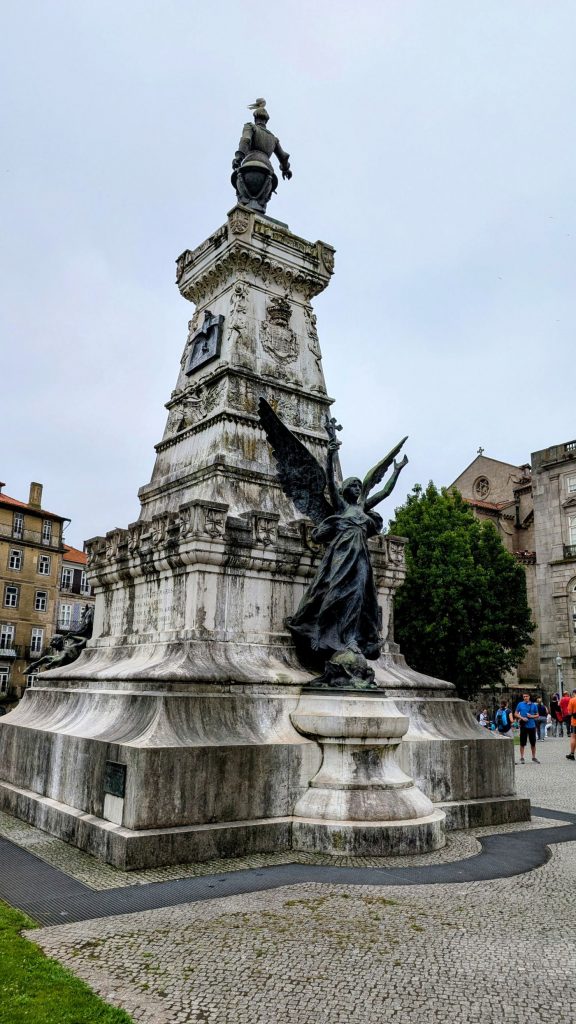
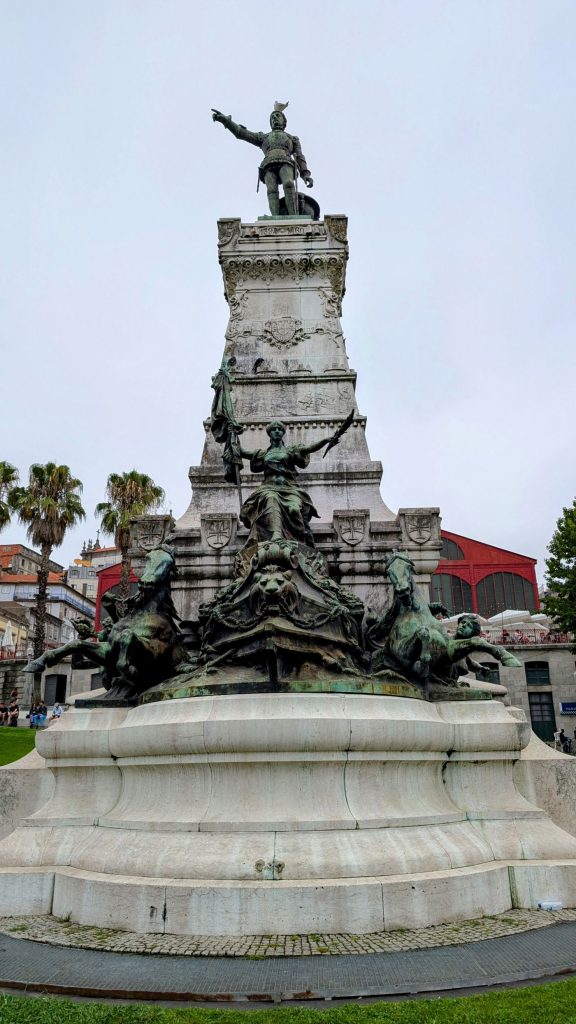
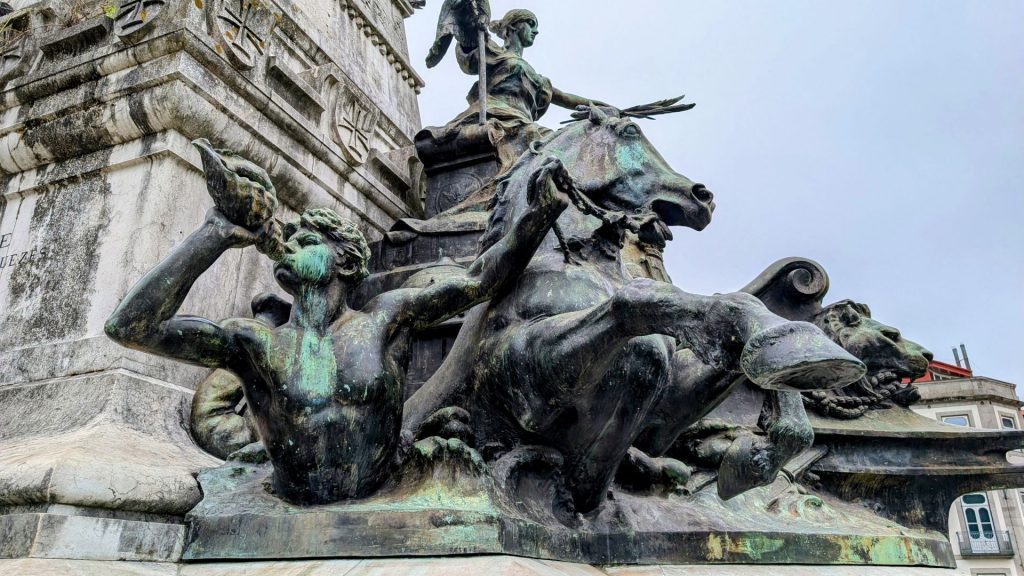
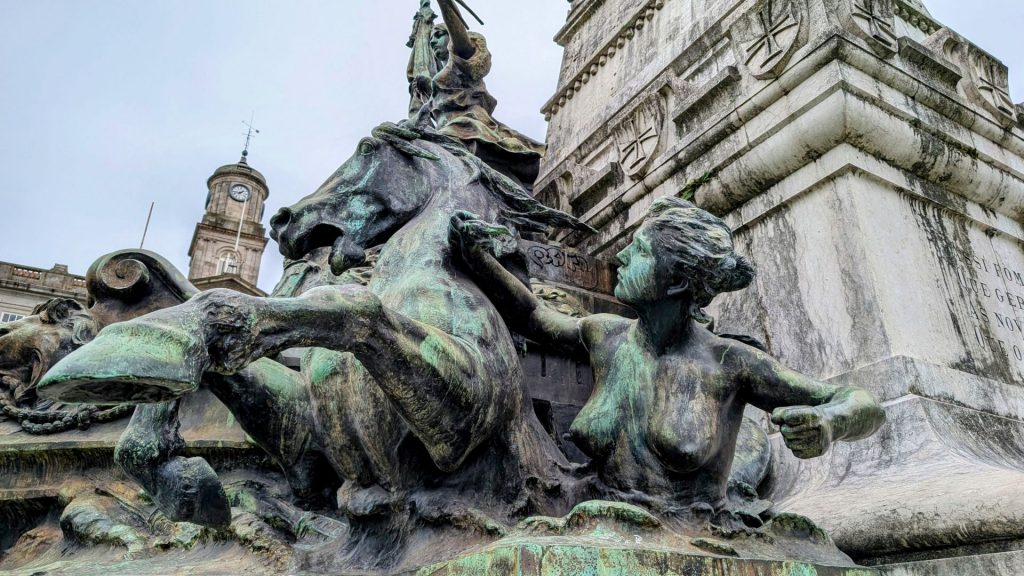
Palacio da Bolsa
This splendid neoclassical monument, built from 1842 to 1910, honors Porto’s past and present money merchants. It served as Portugal’s Stock Exchange for many years. This National Monument, classified as a World Heritage Site by UNESCO, was built by the Porto Commercial Association on the ruins of the Saint Francis Convent. It has become the Porto city’s drawing room, welcoming the most illustrious visitors, amongst which are monarchs, presidents and ministers from almost every country, transforming this building into the most visited monument in northern Portugal.
The first room we visited was the glass-domed Pátio das Nações (Hall of Nations), where the exchange once operated. It is covered by a large metallic, octagonal dome with glass panels, designed by Tomás Soler and built after 1880. The lower part of the dome is decorated with the painted coats-of-arms of Portugal and the countries with which Portugal had commercial relations in the 19th century (this included the US).
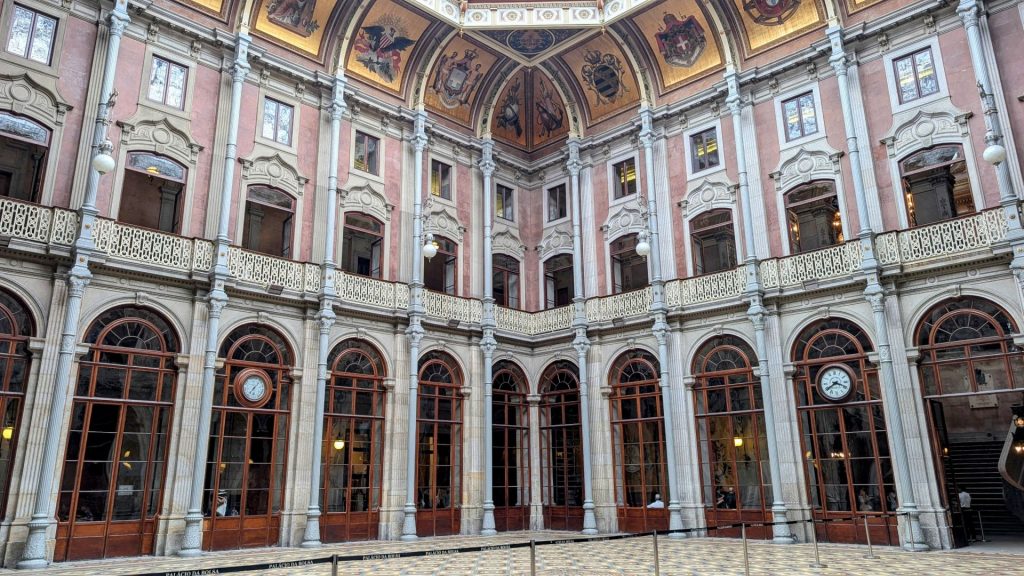
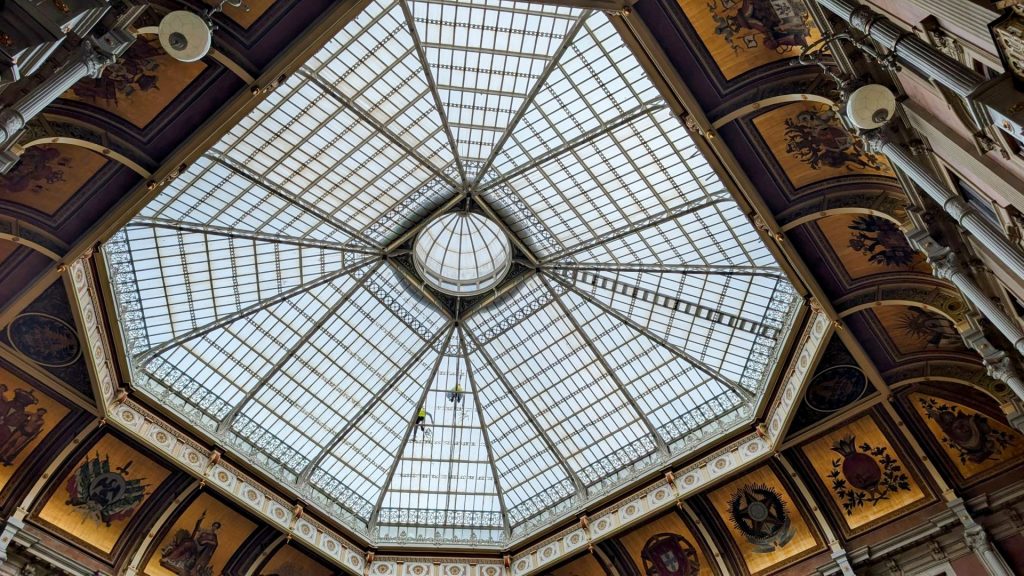
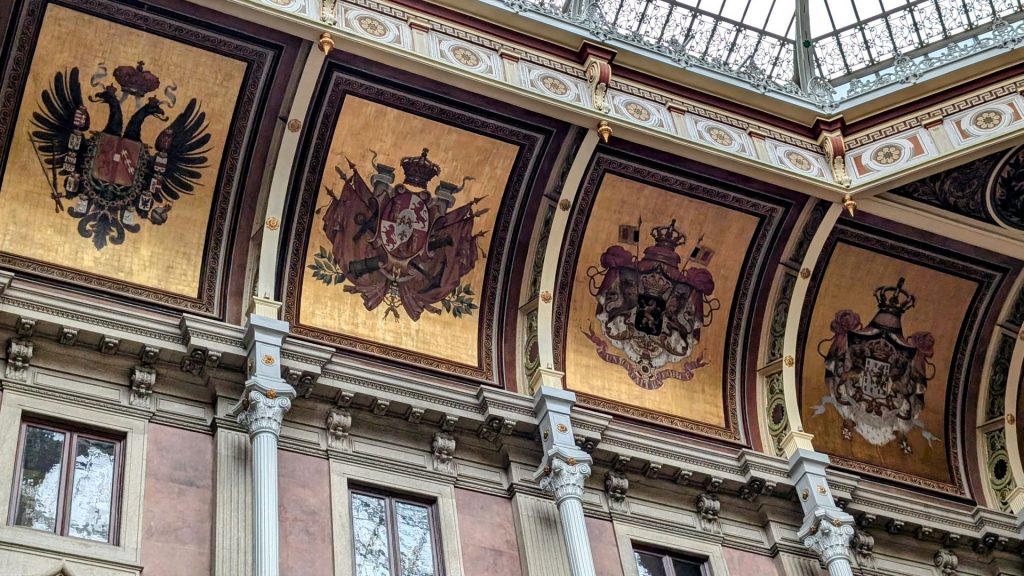
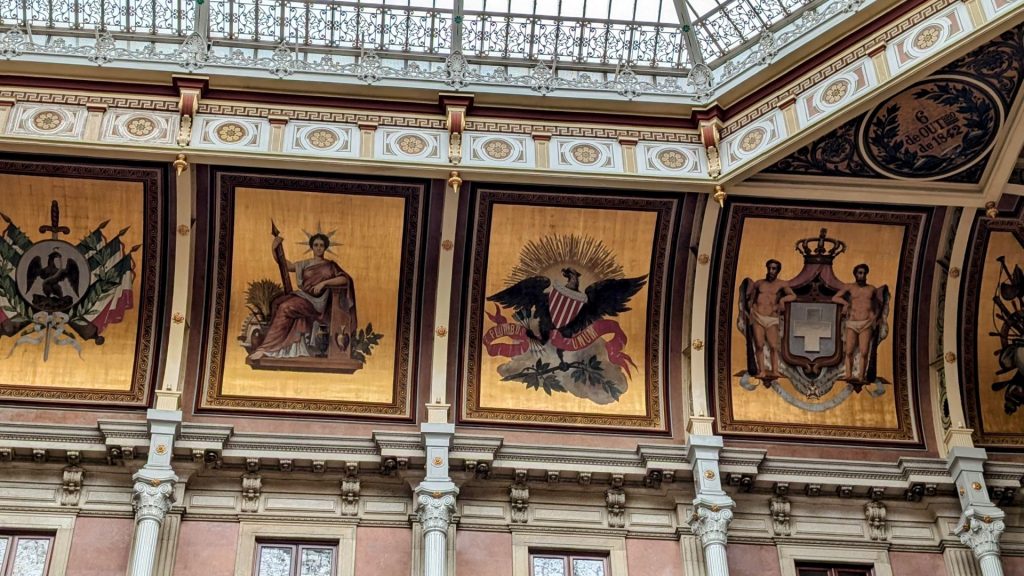
The dome had two bug-like things on it. They turned out to be people. There’s a fun job!
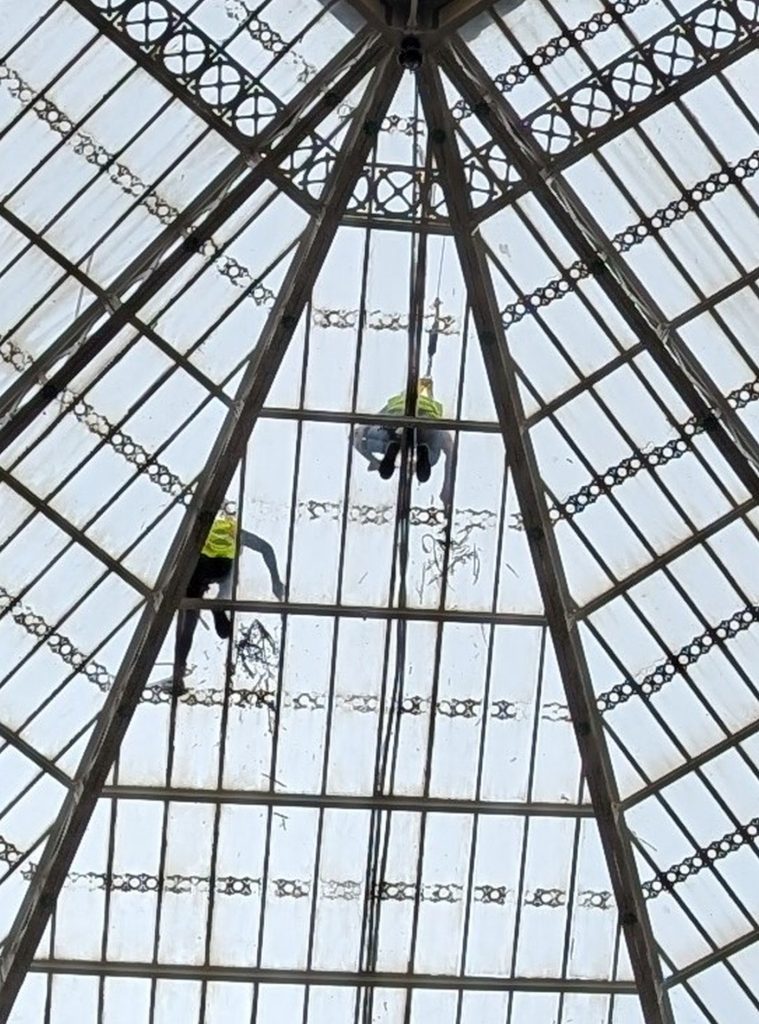
This magnificent staircase is worthy of a spot in a Disney movie.
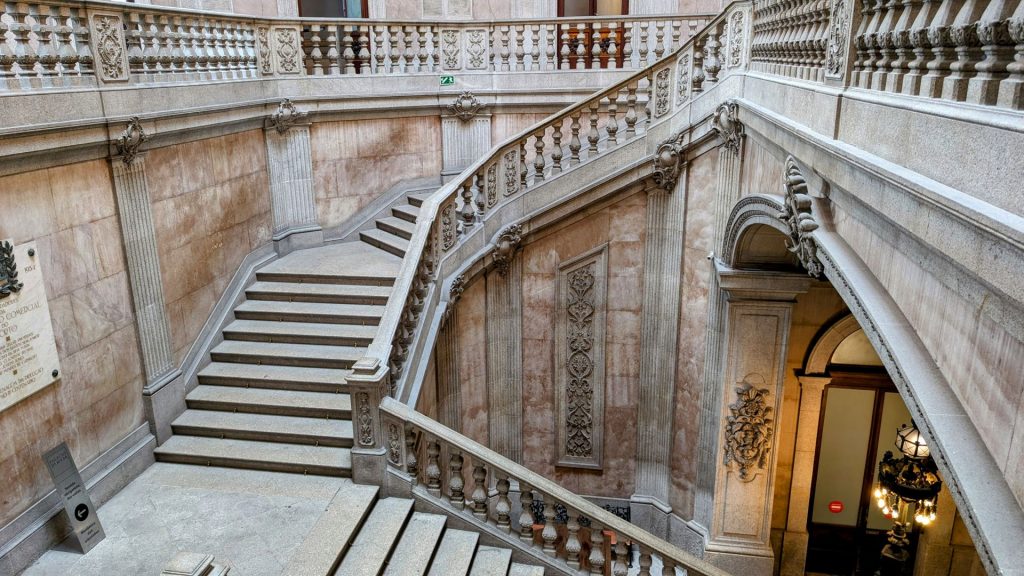
The lights and the sunlight were also lovely!
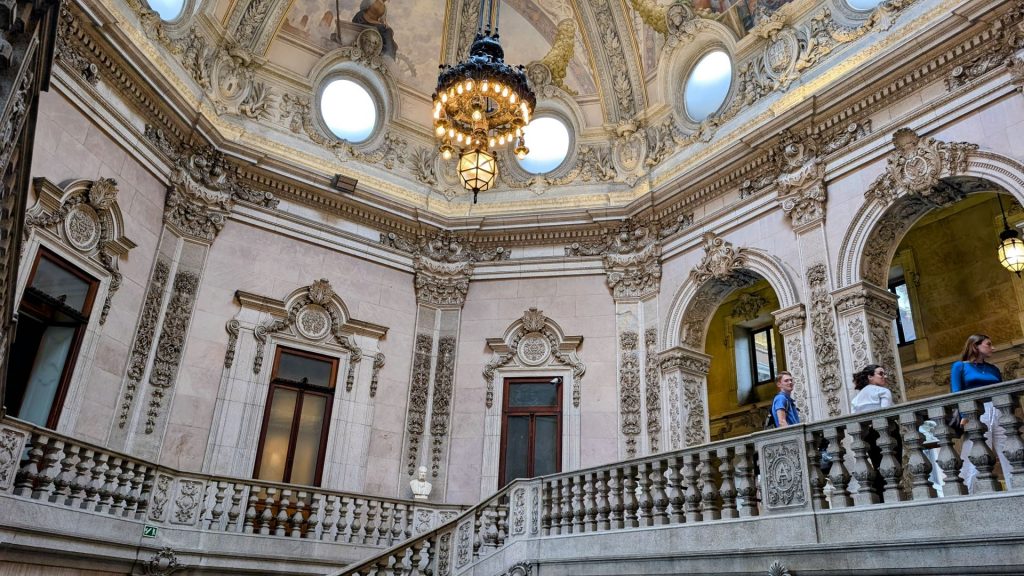
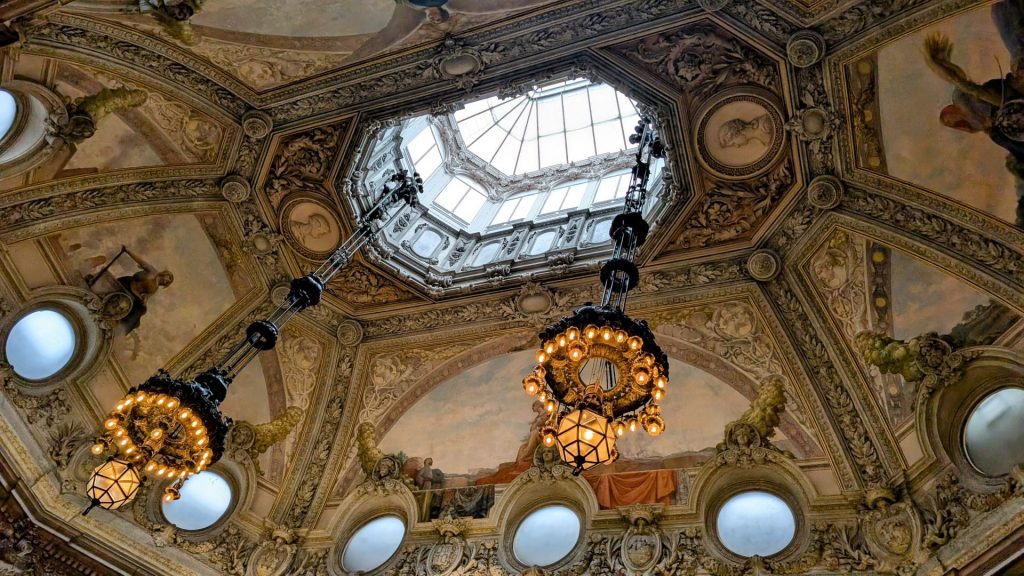
The courtroom is embellished by the magnificent paintings by Veloso Salgado that decorate its walls. The painting on the ceiling includes “justice,” whose eyes are not covered, as justice sees everything we do. (A twist on the idea that justice is blind/blindfolded.)
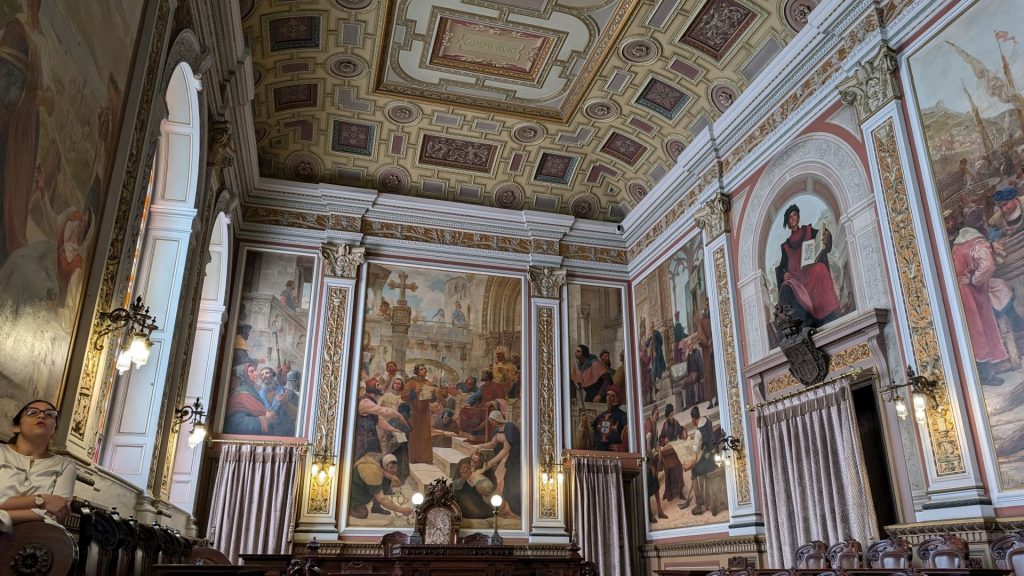
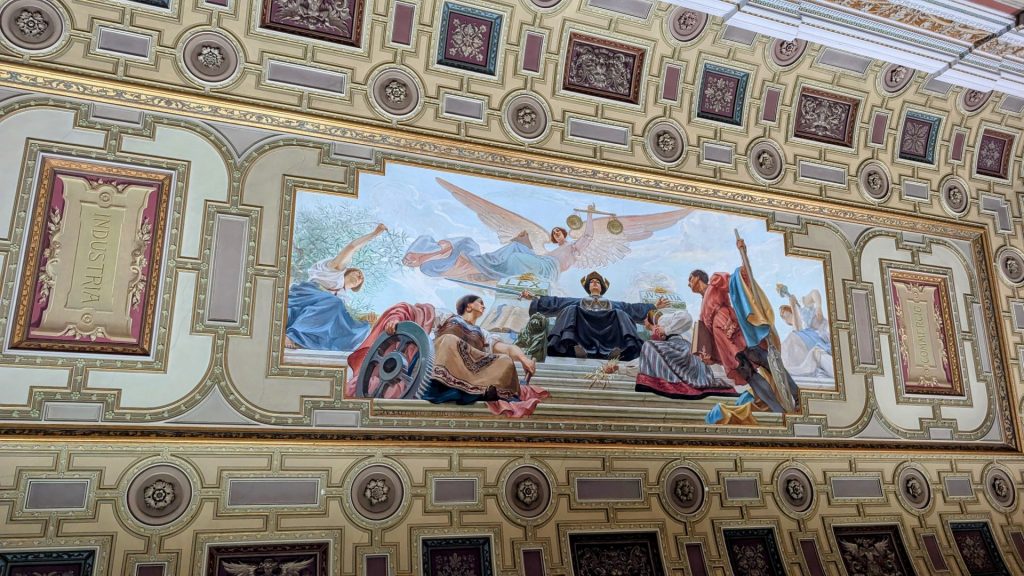
We passed by some offices next. This office displayed Psycho 7 (blue), 2010. It is made of aluminum and is 42 x 47 x 15 inches in size. There was a sign describing it, which I am sharing beneath the work. You’re welcome.

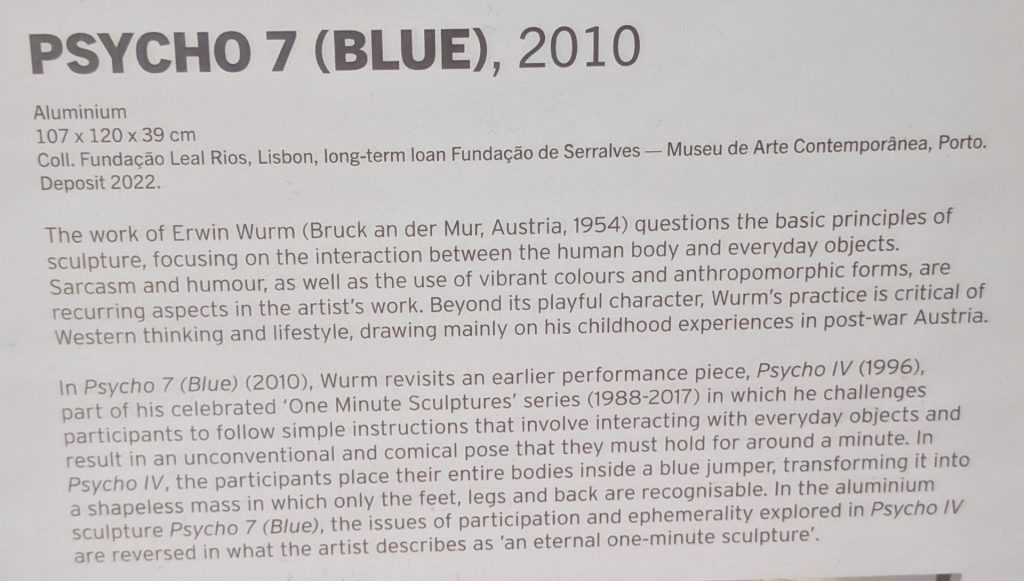
The next office we visited had been inhabited by none other than Gustave Eiffel, the engineer behind the Eiffel Tower in Paris. The Dom Luís I Bridge (you can see it from the office’s window), is famous in Porto. It was designed by Théophile Seyrig, a talented student who studied under the renowned Gustave Eiffel.
The main purpose behind the creation of the Dom Luís I Bridge was to connect the cities of Porto and Vila Nova de Gaia, which were historically separate entities. The need for a reliable and efficient transportation link was ever-increasing, and this double-decked iron bridge was the solution. The upper portion of the double-decker bridge is used for the Porto metro and also has a pedestrian walkway. The lower section is open for use by both pedestrians and vehicles alike.
The construction of the bridge began in 1881 and was completed in 1886. The task of engineering and building the bridge was a demanding one: the river was fast-flowing, up to 20 m (66 ft) deep, and had a bed formed of a deep layer of gravel which made the construction of piers on the river bed impossible, and so the bridge had to have a central span of 160 m (520 ft). This was greater than the longest arch span which had been built at the time. Construction of the bridge was a testament to the engineering prowess of that era.
The bridge was named after King Dom Luís I, who ruled Portugal from 1861 to 1889 and left an indelible mark on the country’s history.
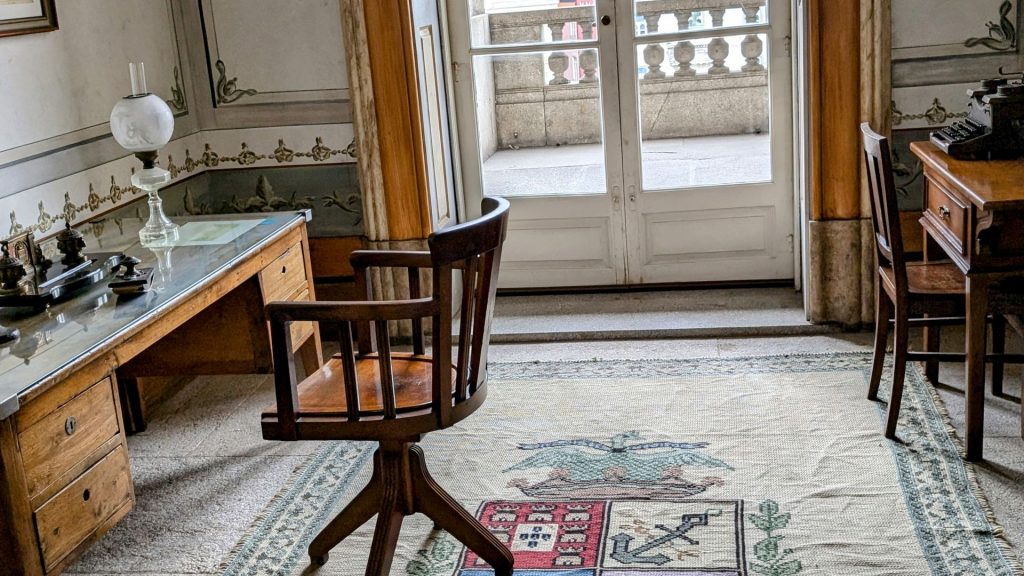
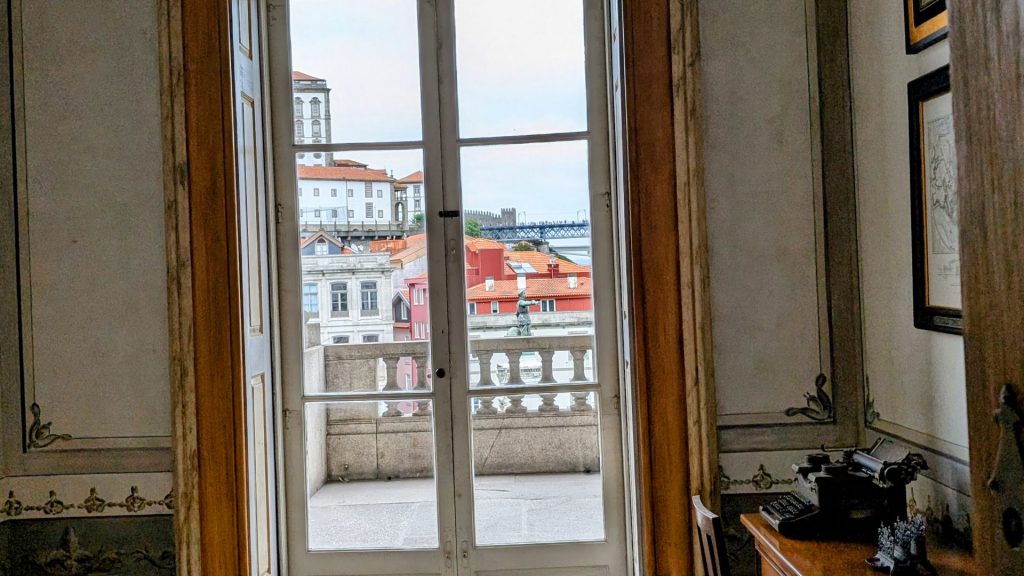
Here are some more pictures of the bridge:
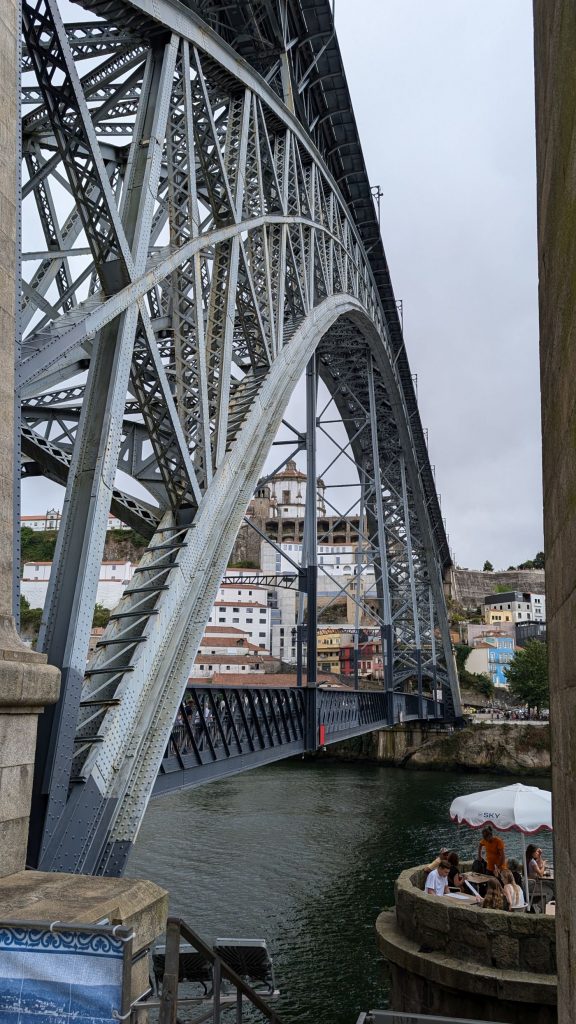
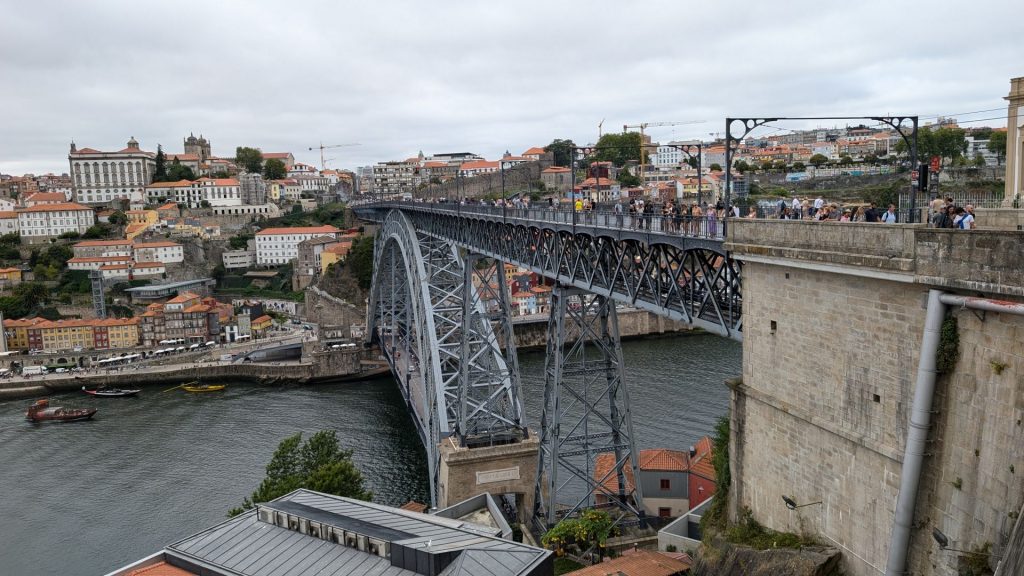
Back to the palace.
The Portraits Room
On the walls, the portraits of the last Kings of Portugal are a highlight. There is also a beautiful wooden table in the room.
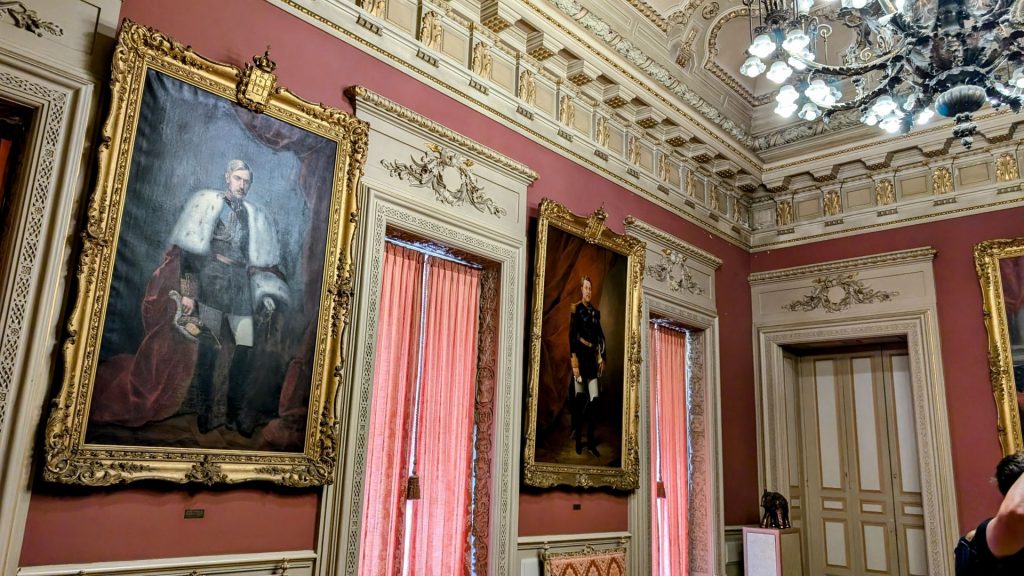
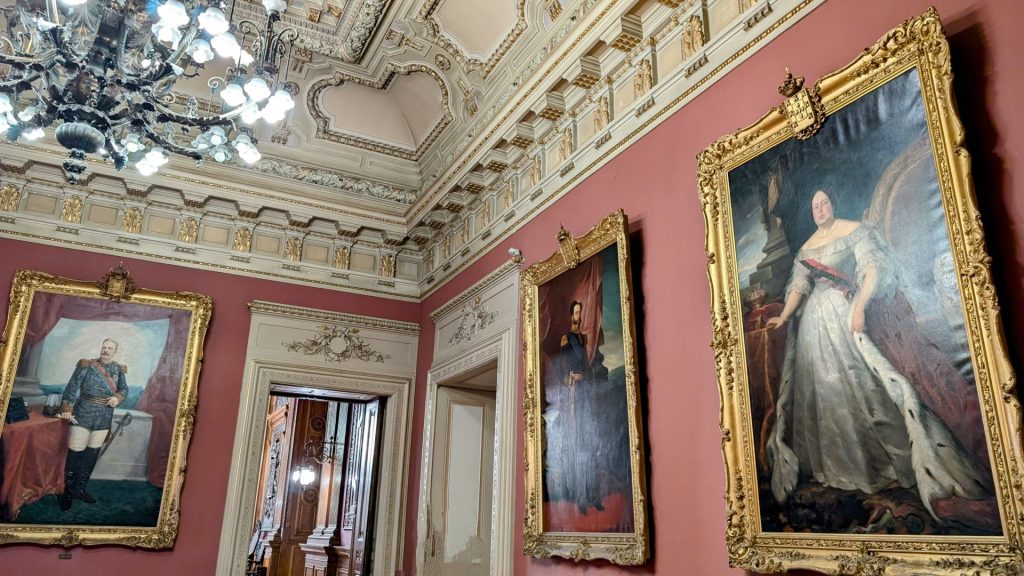
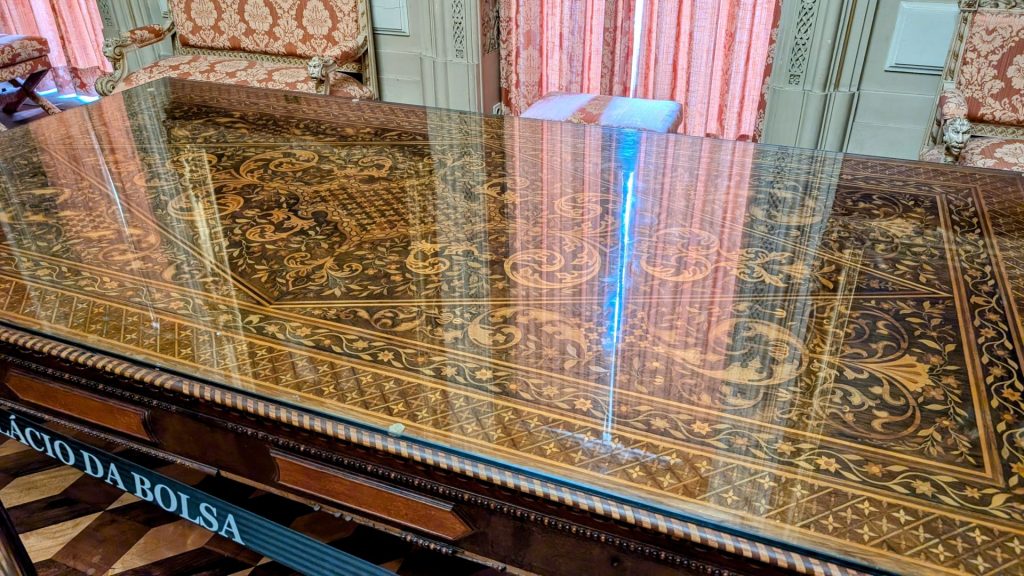
The Golden Room
This room is also called Room of the Board because the Management of Associação Comercial do Porto, who owns the Palace, holds its meetings here.
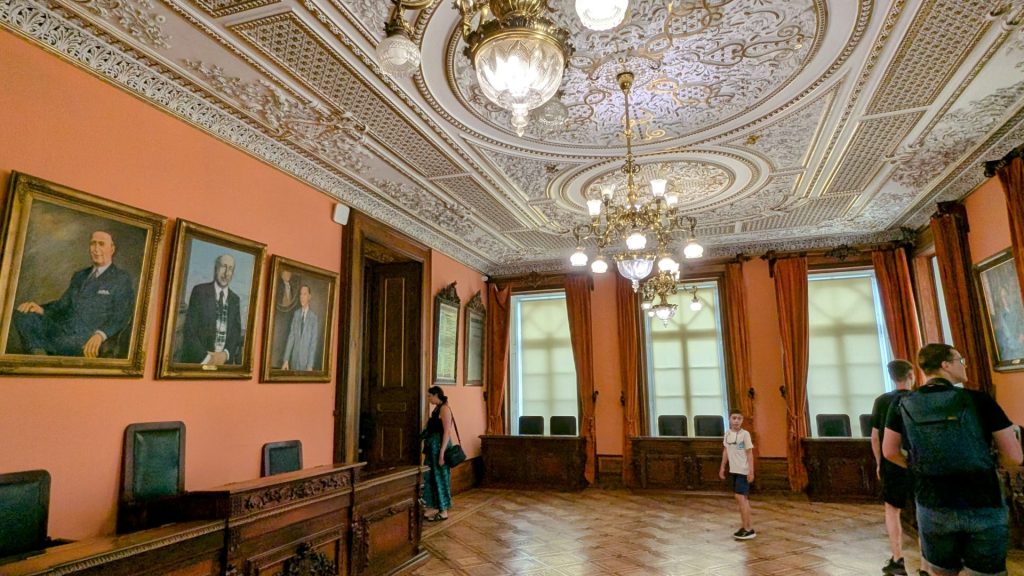
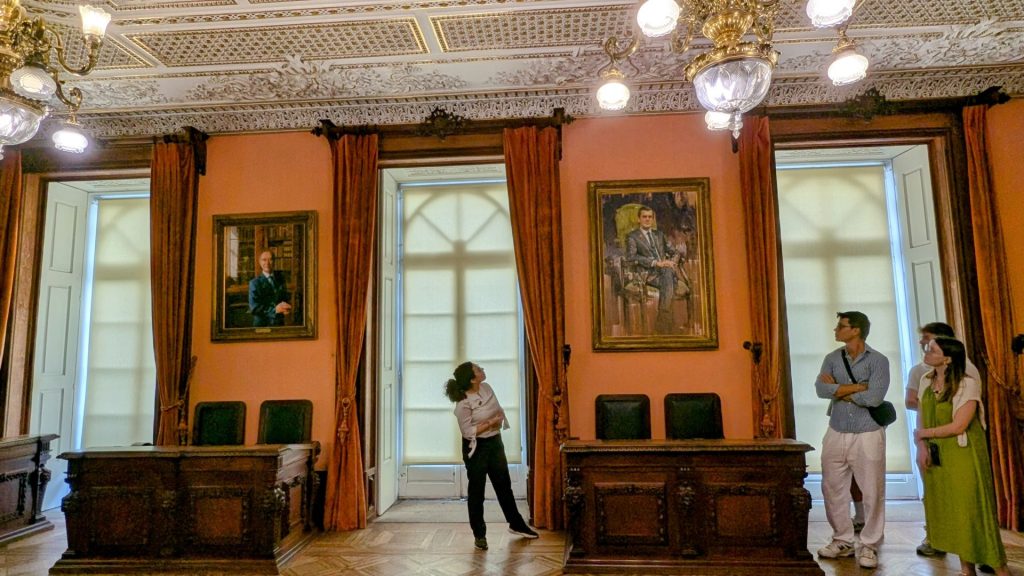
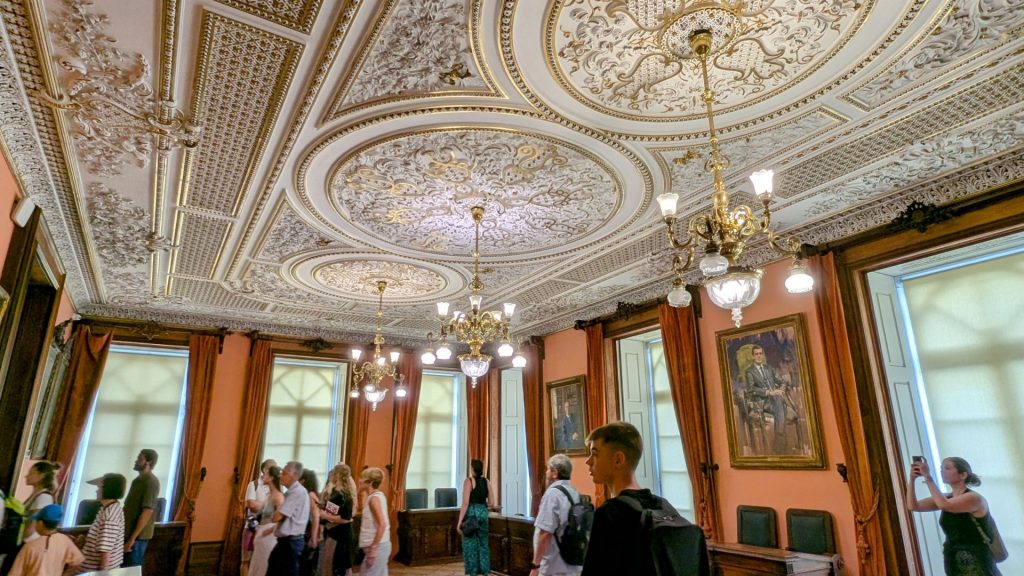
General Assembly Room
This room has paneled walls and ceiling and a more sober style.
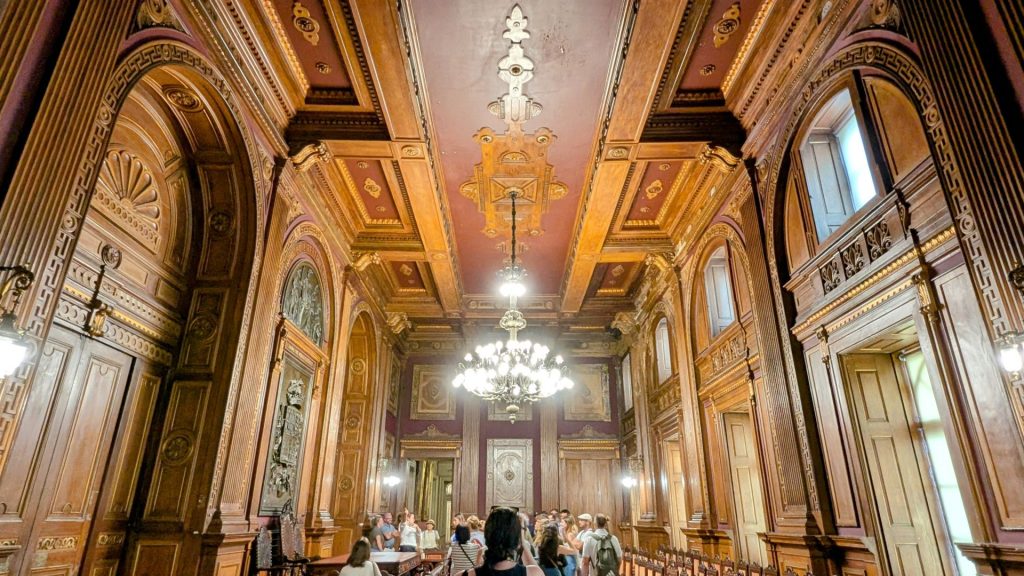
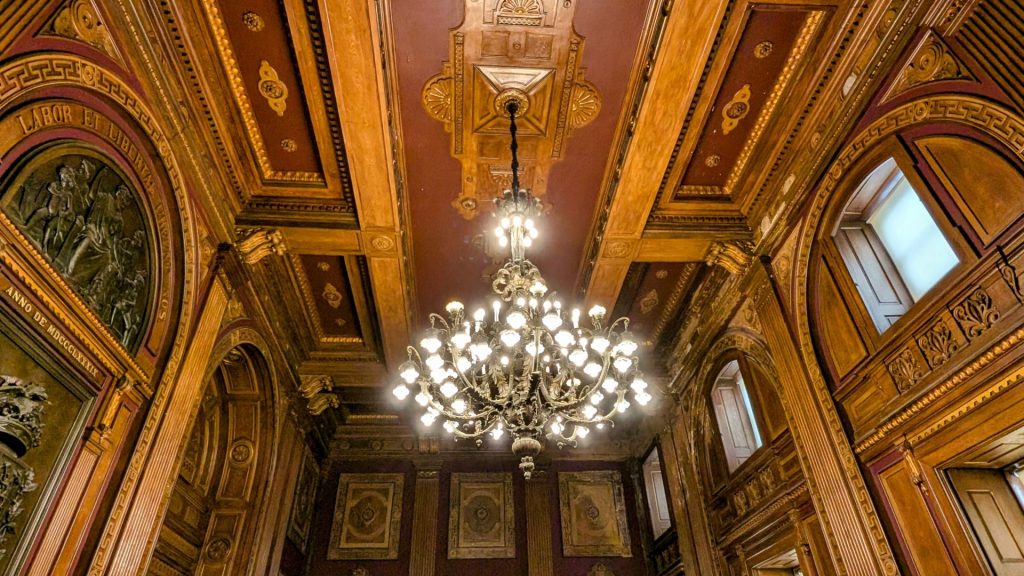
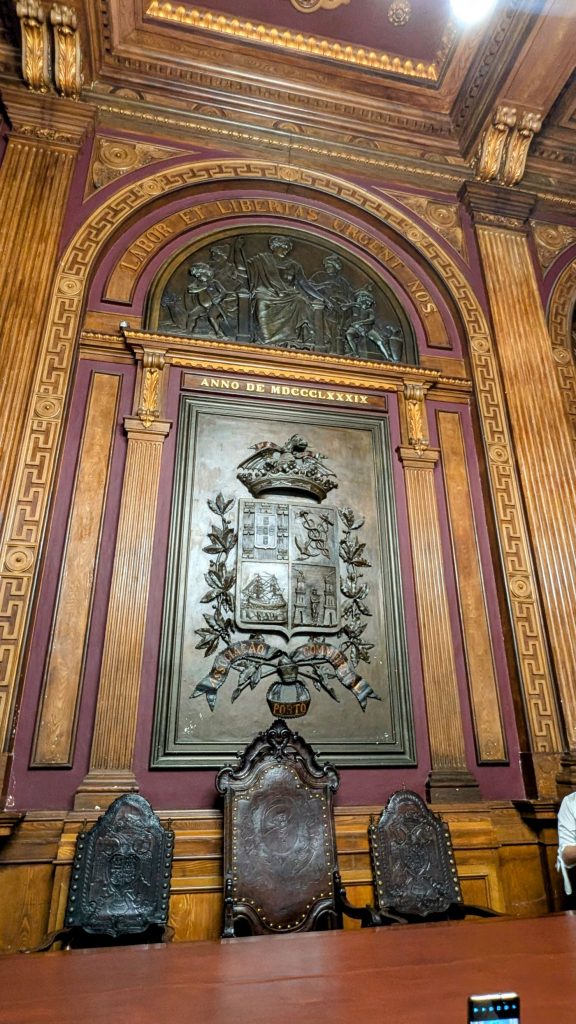
Arabian Room
The highlight is a stupendous ballroom known as the Salão Árabe (Arabian Hall), with stucco walls that have been teased into complex Moorish designs, then gilded with some 18 kg of gold. Exotic and singular in its Arabian inspiration, the space is perfect for an event aiming to be staggering. With an excellent acoustic, in it one can hold concerts, conferences and dinners.
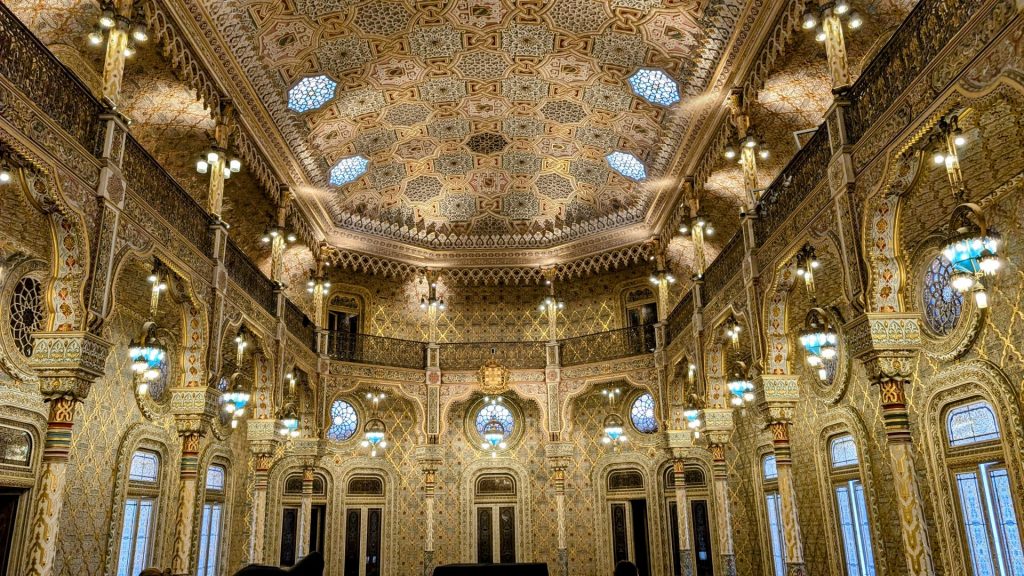
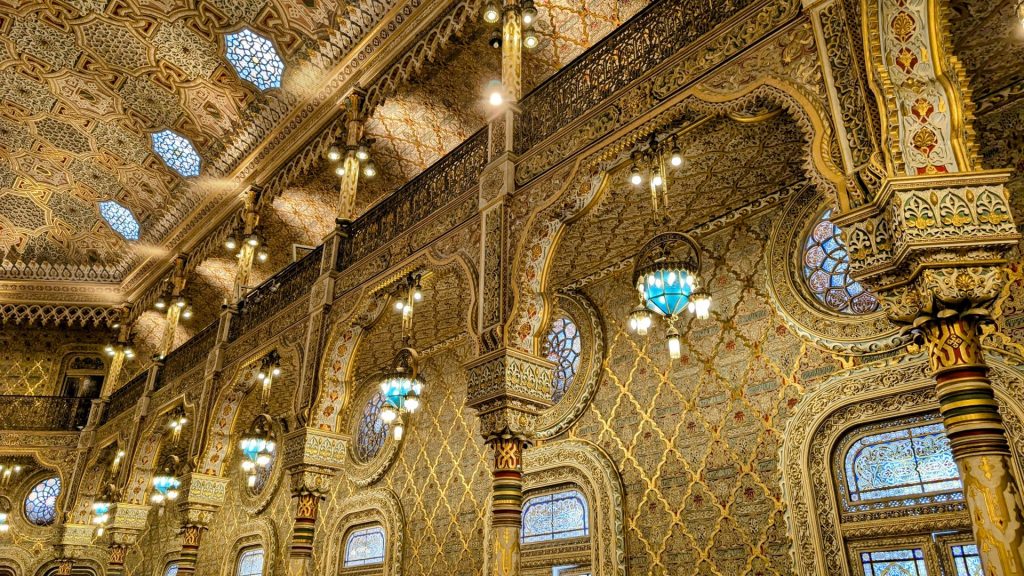
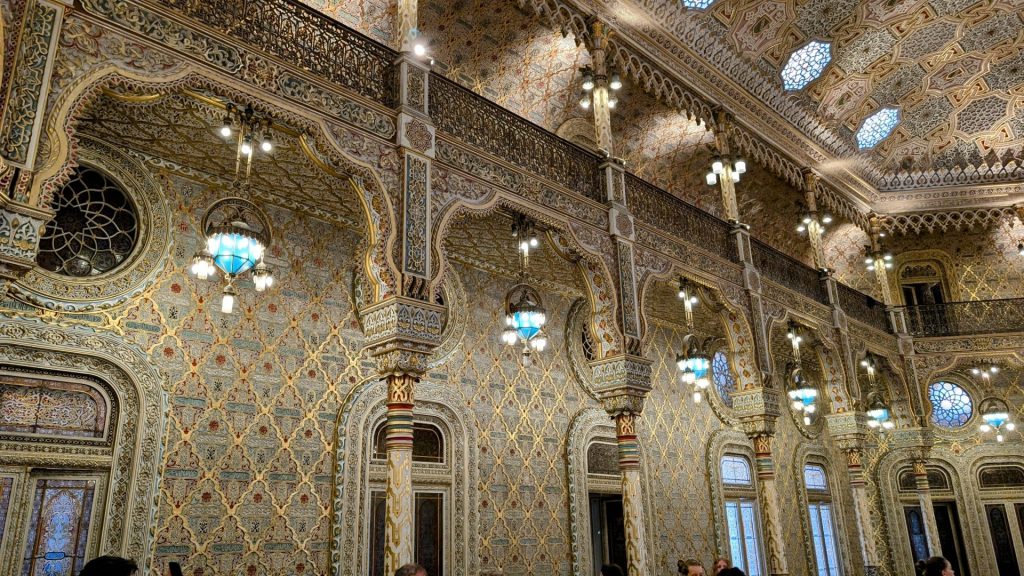
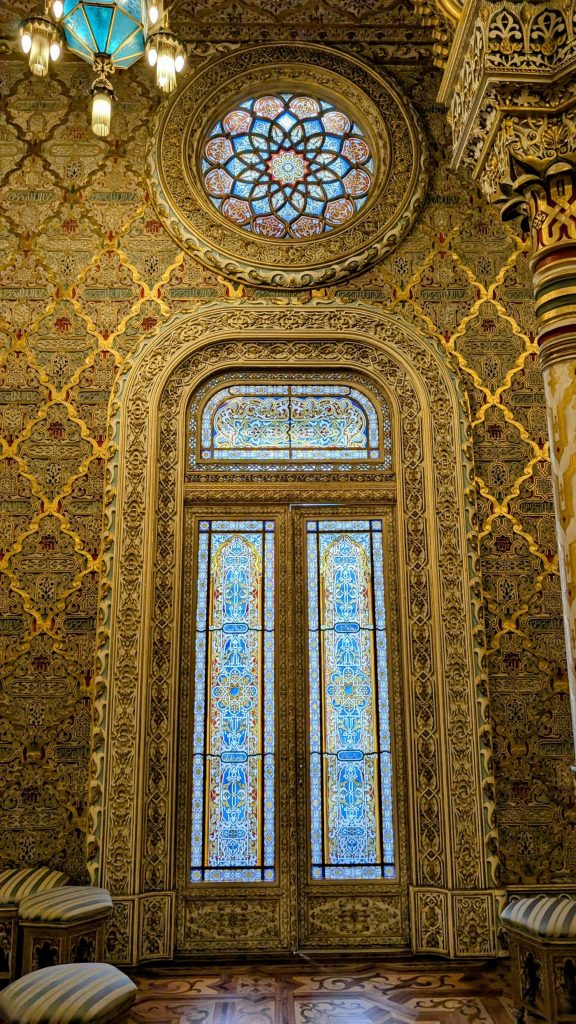
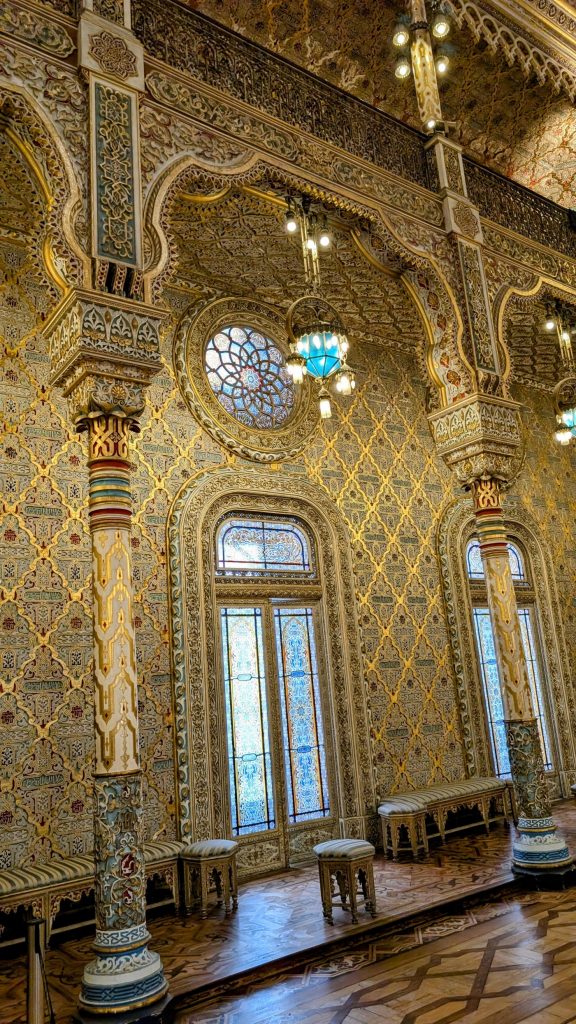
We crossed the river on the lower level of the Dom Luís I Bridge. Then I walked to the top of a hill and Michael took the cable car, after which we both enjoyed bird’s-eye views of both Porto and Gaia. We took the upper level of the Dom Luís I Bridge back.
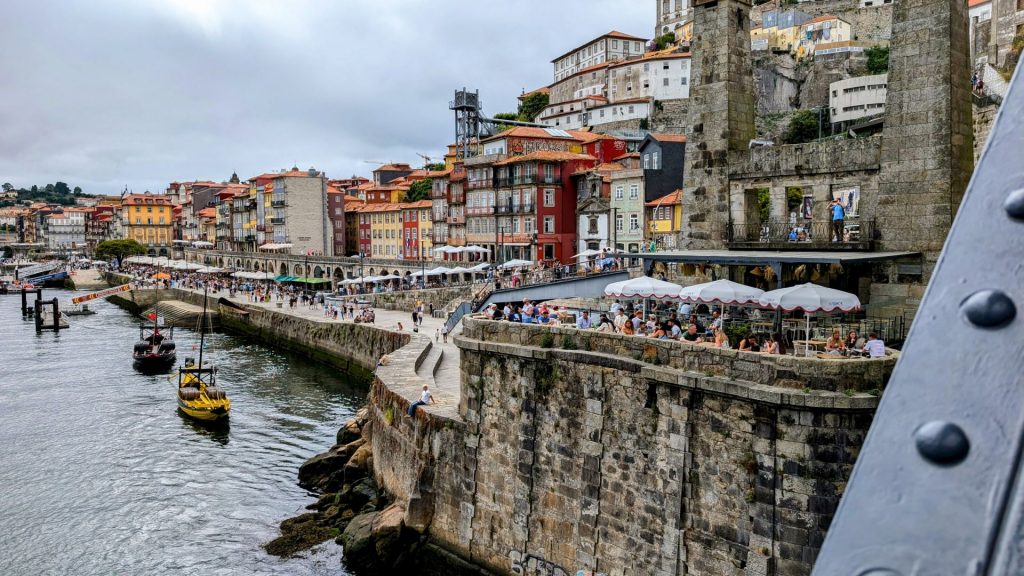
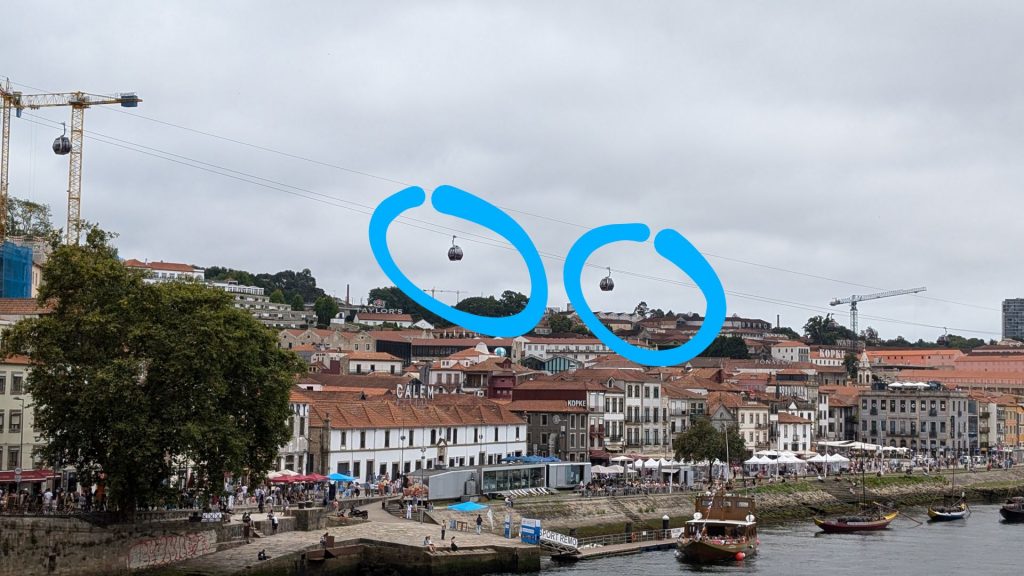
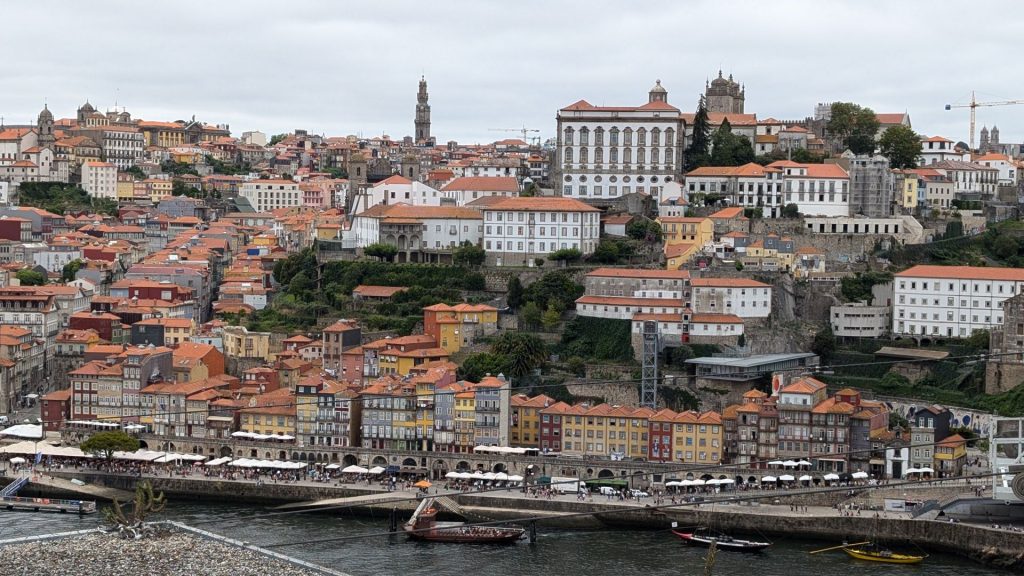
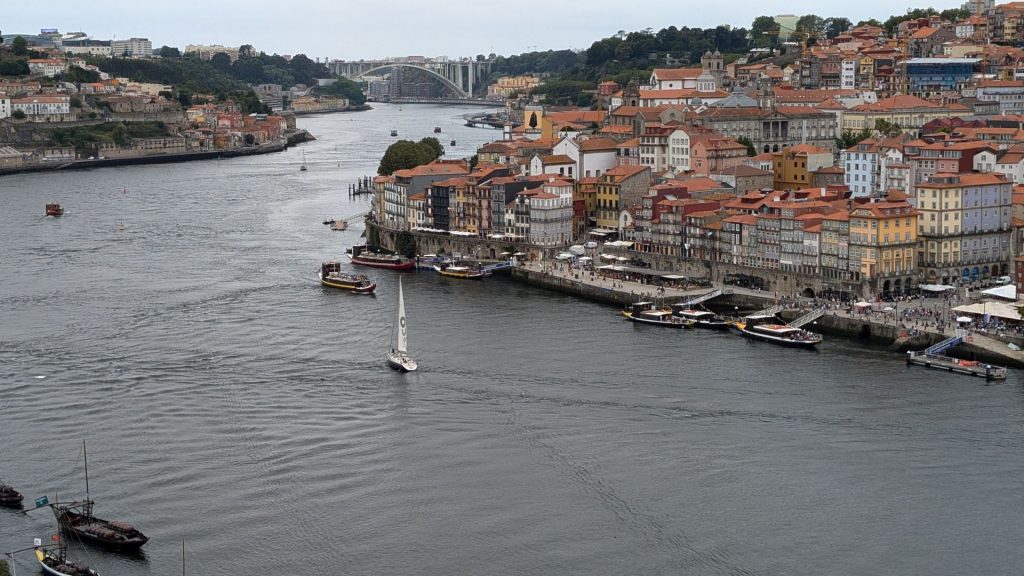
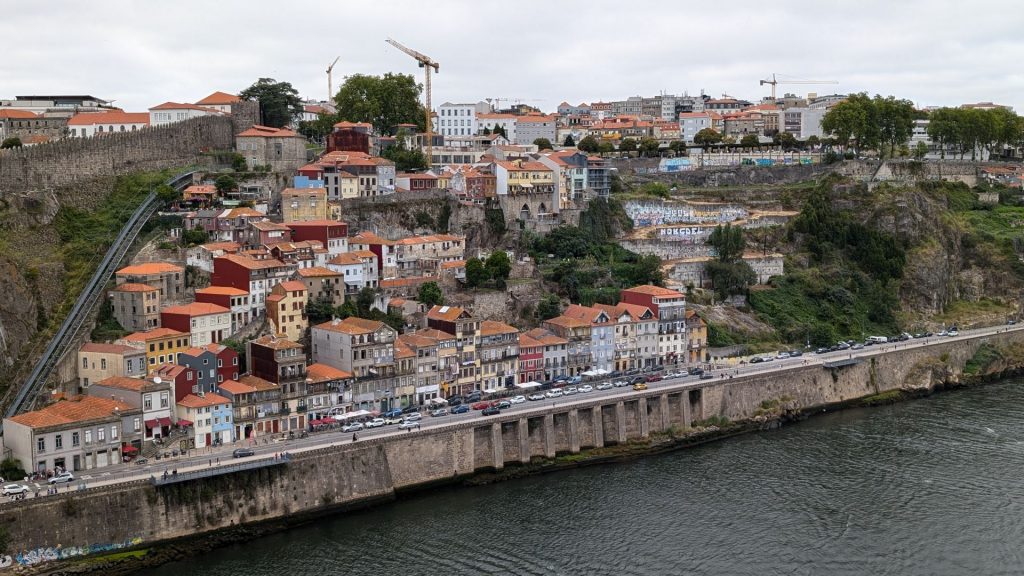
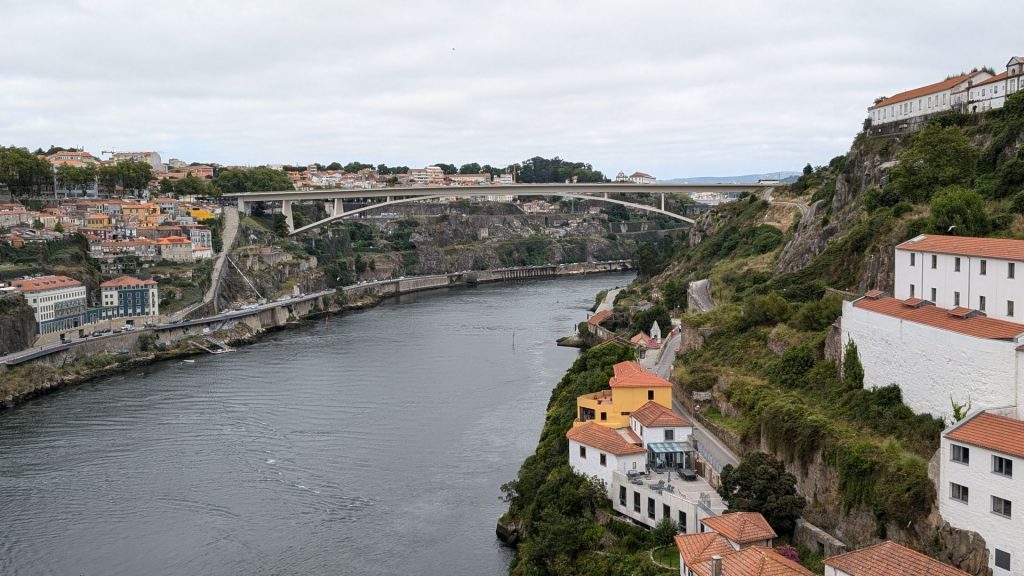
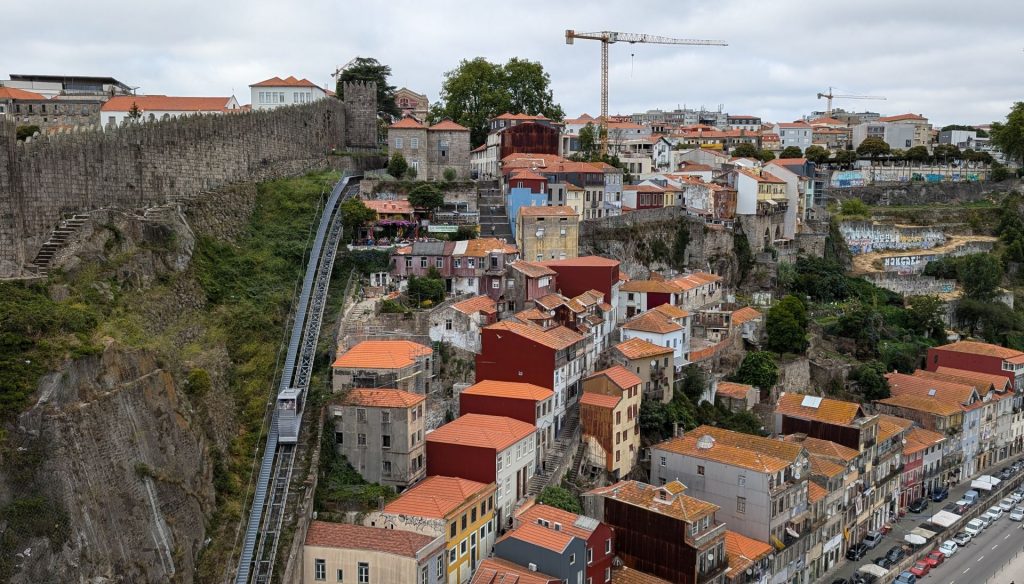
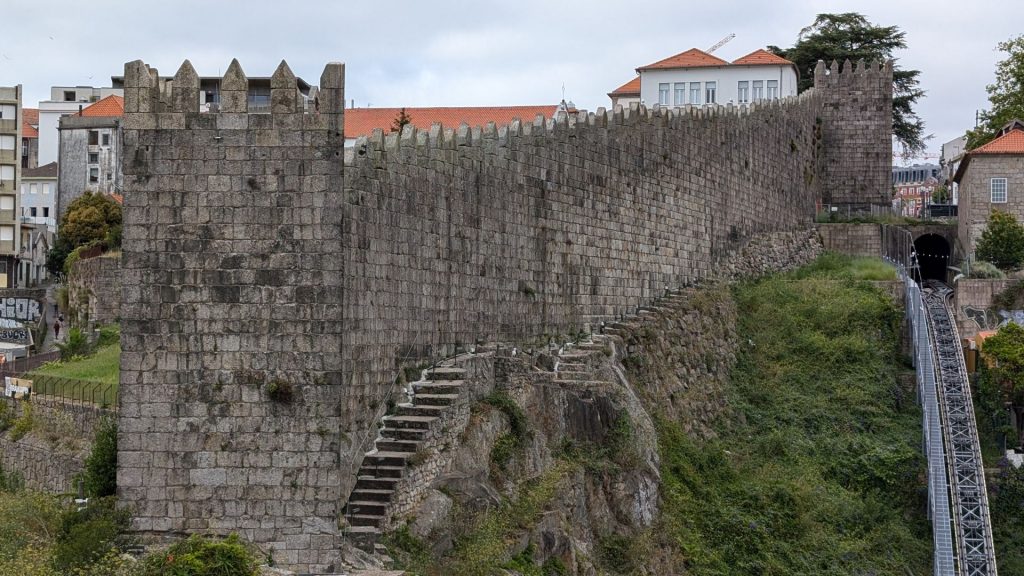
It was time to walk back to the hotel for Michael. It was time to visit a bookstore for me! We passed this pretty building on the way. It is the Clérigos Church. There is a tower at the other end that you can see in the background.
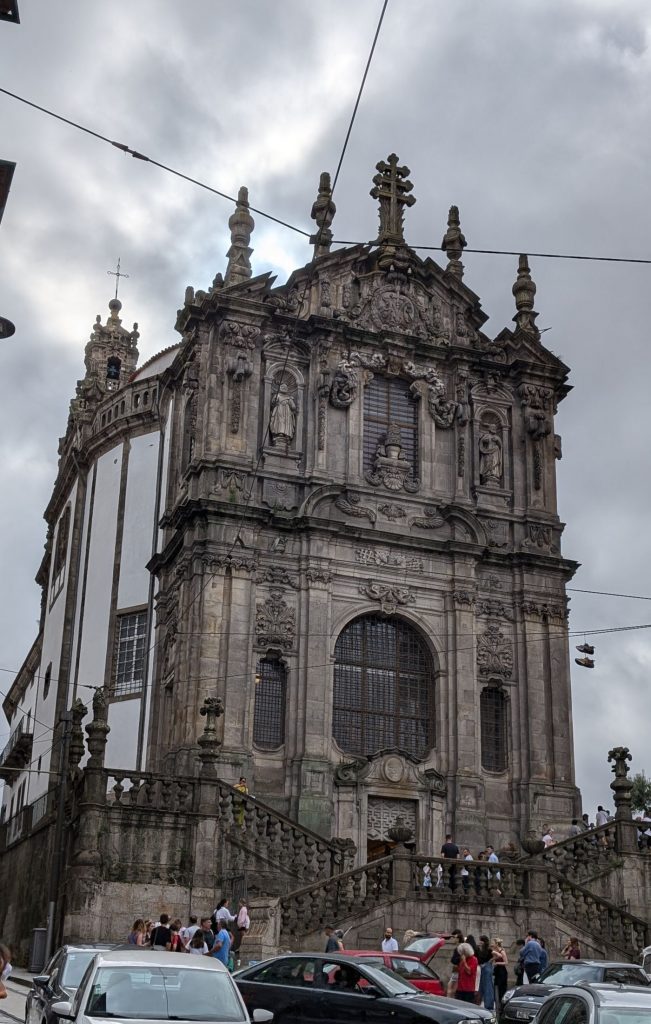
First, my dear reader, thank you for hanging in this long. I have one more thing to share in today’s post, and it is totally worth waiting for!
It is Livraria Lello Bookstore! Yes, you read that correctly: a bookstore. In fact, it is The Most Beautiful Bookstore in the World.
I bought the “Romeo and Juliet” ticket, which allowed me to skip the line. Yes, you also read that right: you have to buy a ticket and reserve a time to visit Livraria Lello. That is how popular it is!
Why is it popular? Well, you will fall in love with it when you see the pictures, but it also has great books . . . and a Harry Potter connection. Rumor has it that J.K. Rowling’s inspiration to write Harry Potter began in Porto, particularly at this store. The well-known writer lived in Porto while working as an English teacher in the early 1990s and she used to drink a cup of coffee on the second floor of Lello’s bookstore. There are indeed great similarities between Lello’s bookstore staircase and the one described in Hogwarts.
Let’s just jump right in and visit it.
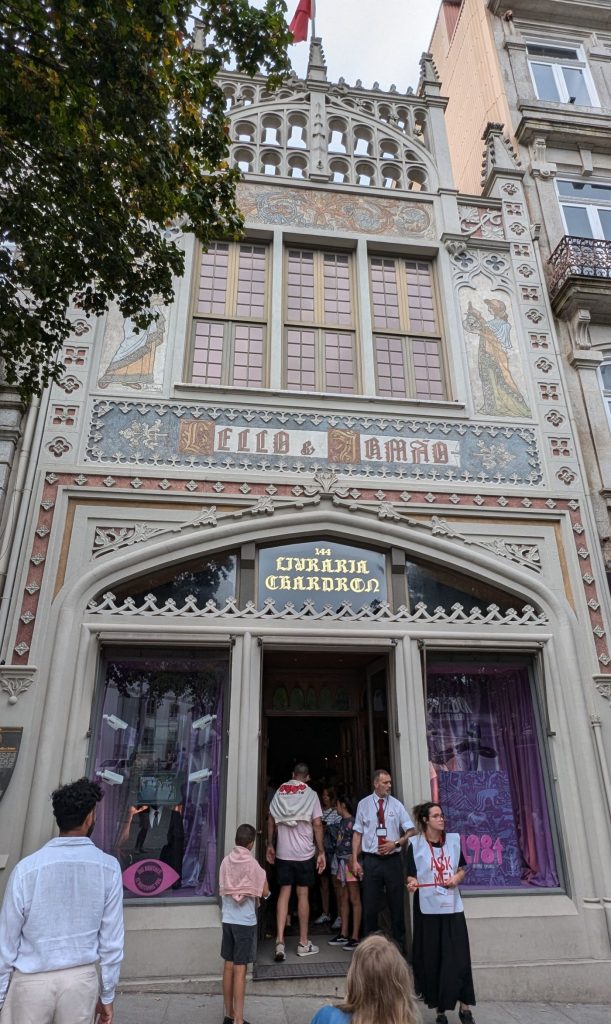
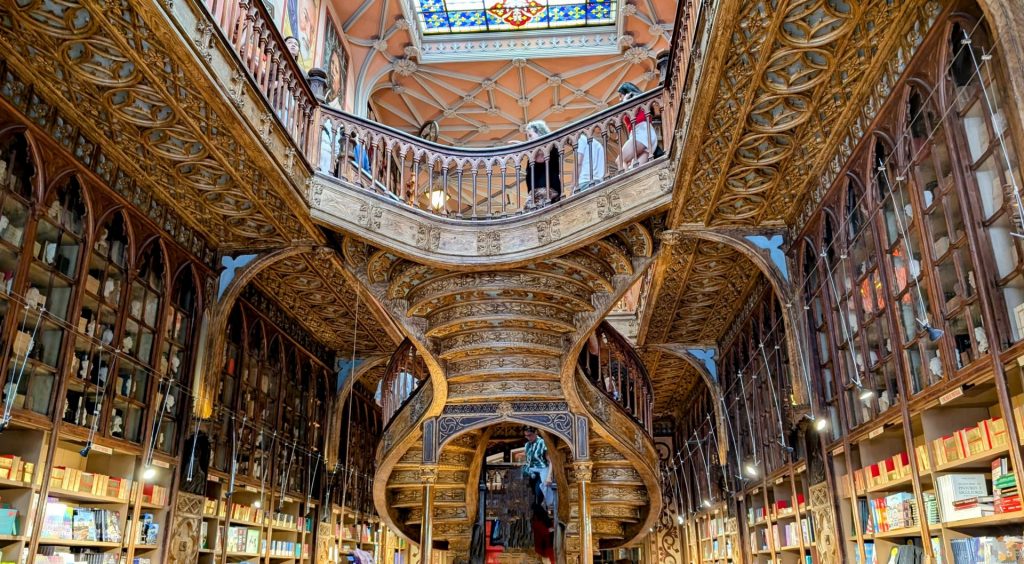
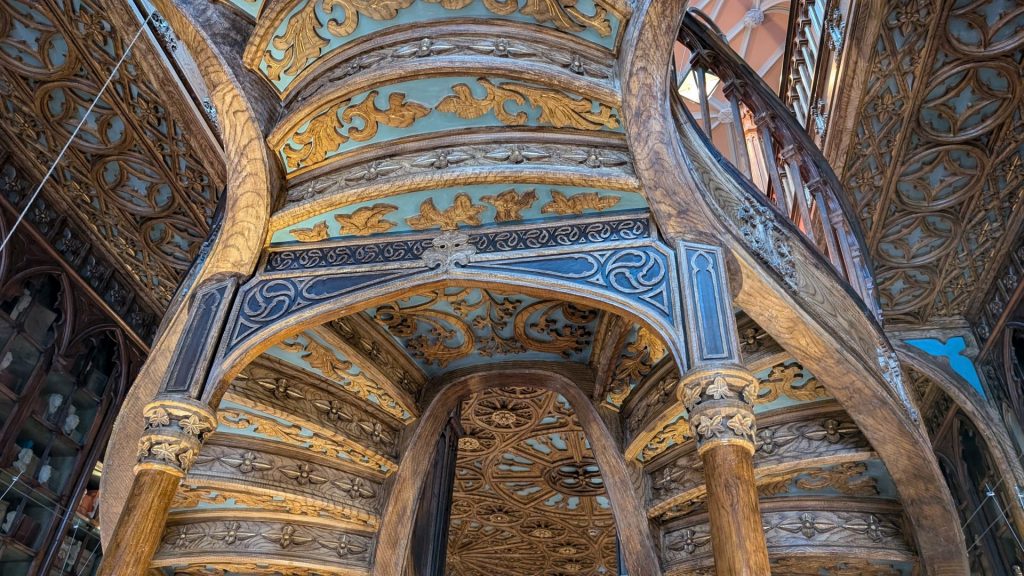
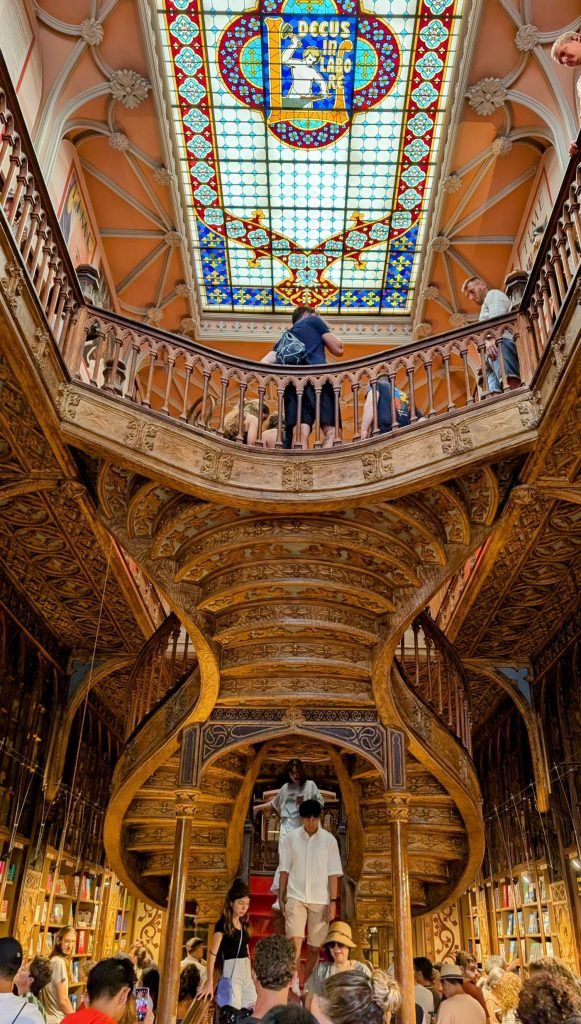
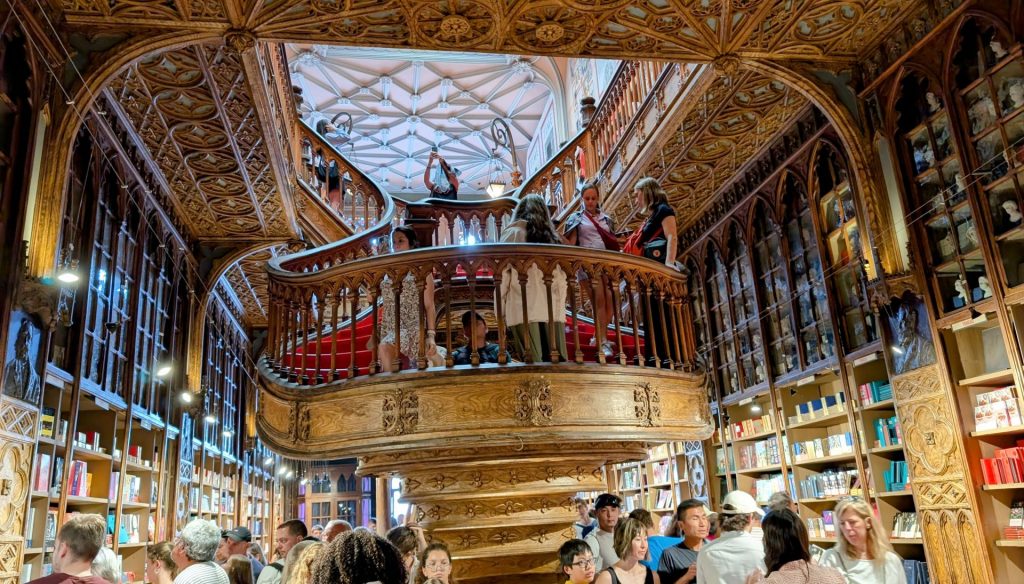
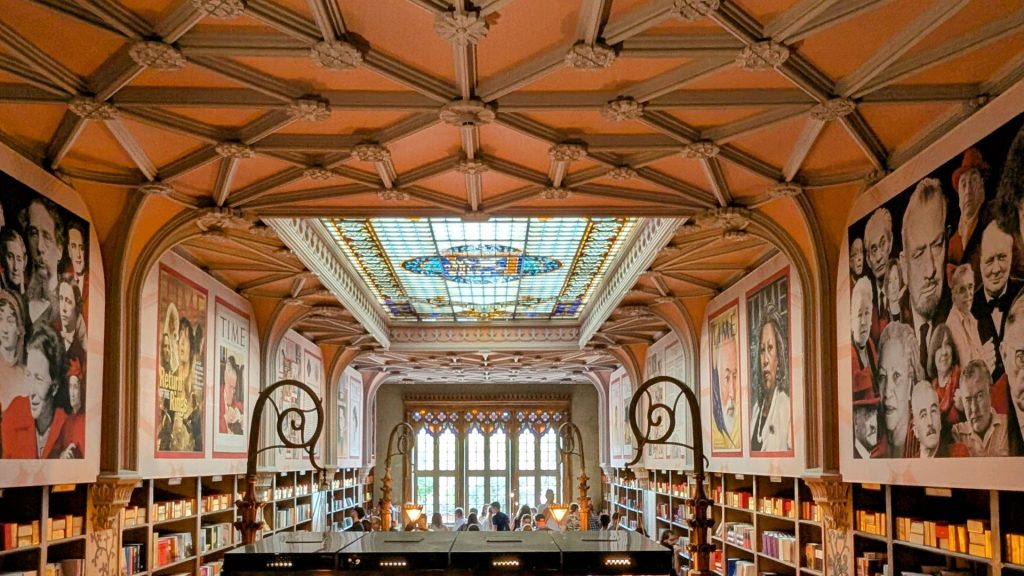
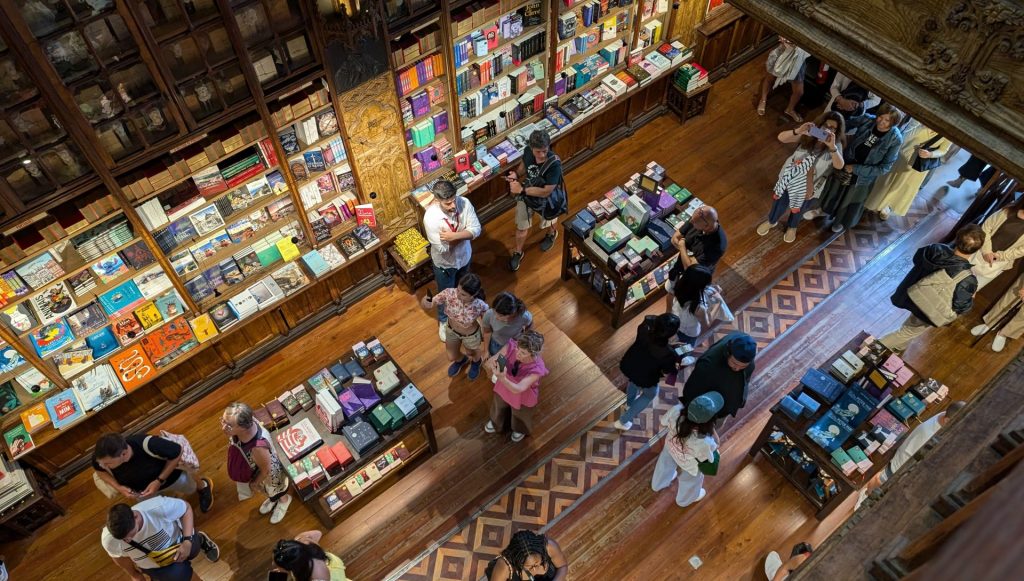
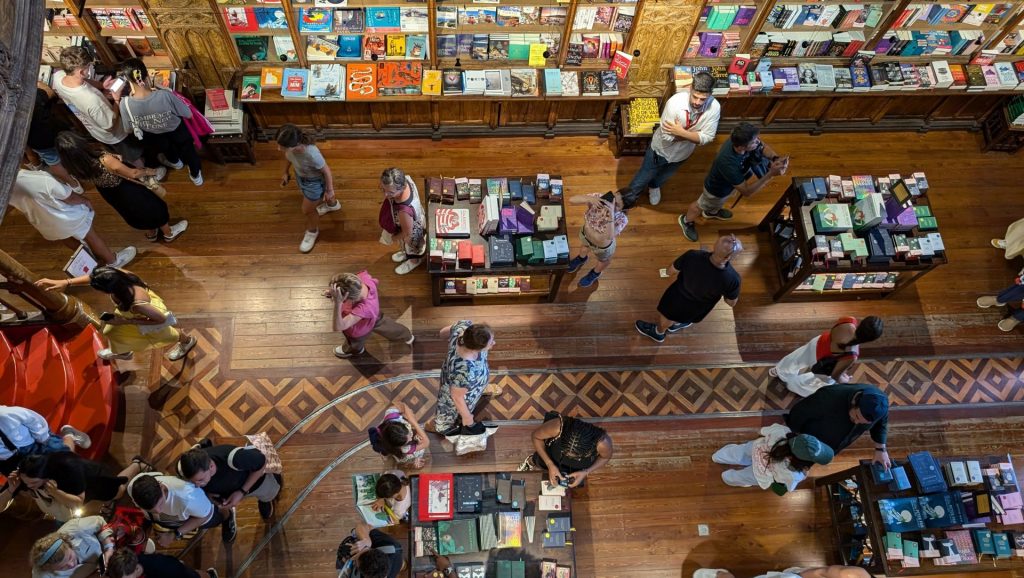
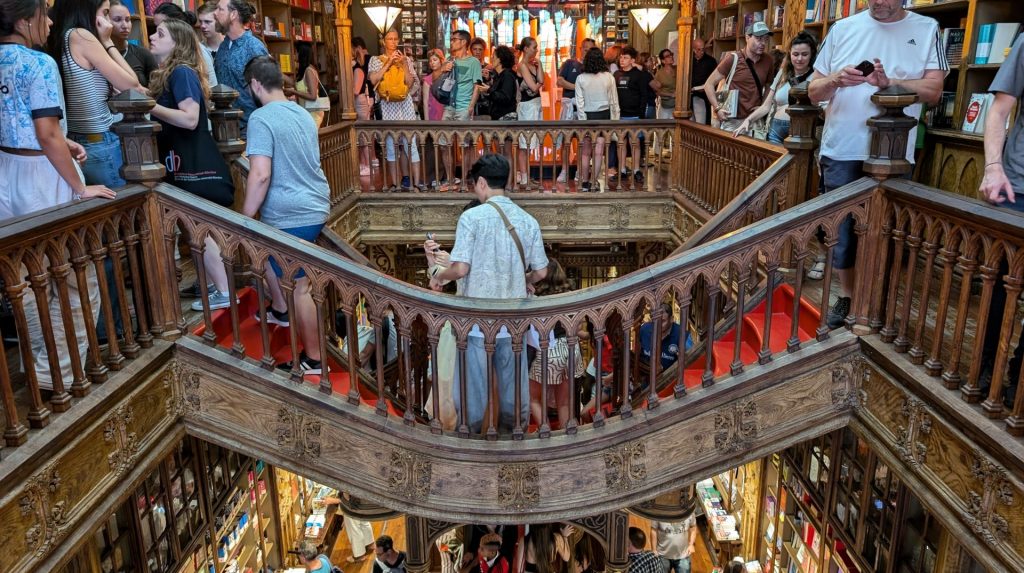
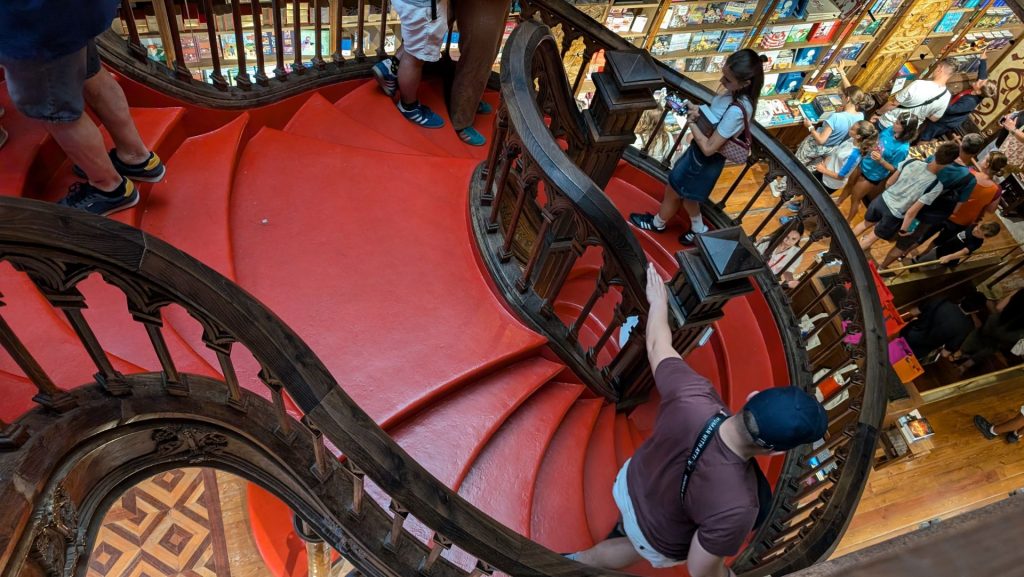
Yes, I bought a book. And I got one for “free” with my entrance ticket. I selected the novel because it was written in English, is a nod to our recent visit to the UK and Ireland, and the print is large enough for me to read!
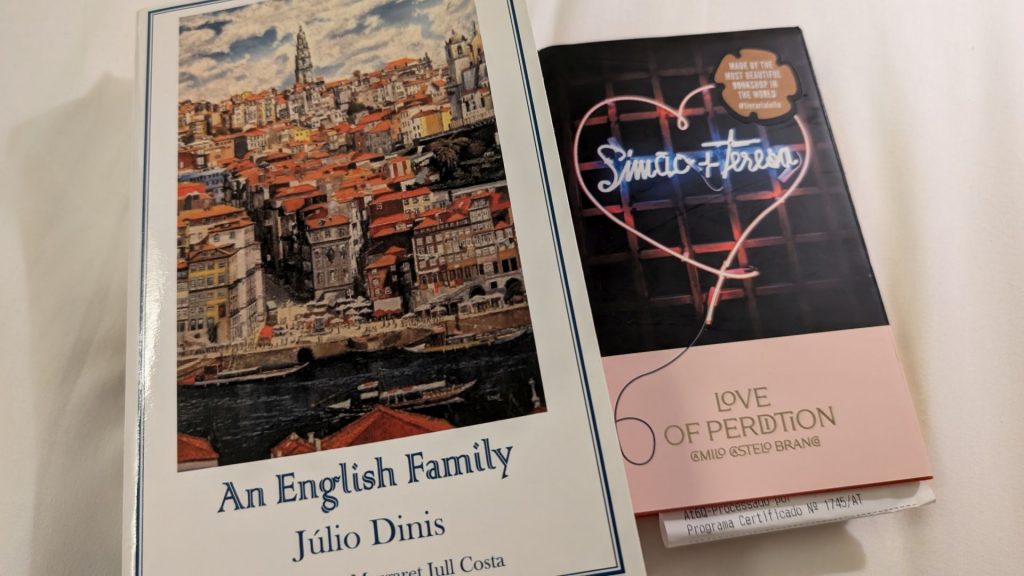
Our next post will contain pictures of our visit to the interior of northern Portugal.
